Top 25 Most Beautiful Castles in the World
Posted in Features on January 23, 2008By Sarah Scrafford
Everyone seems to know that the most luxurious castles are located in Europe. Or, are they? As we traveled the world we learned that castles exist everywhere. From South Africa to Louisiana and from New Zealand to Iran, a curious traveler can find a castle in just about every corner in the world.
Just to prove this theory to you, we’ve gathered twenty-five amazing castles from around the world for your perusal. This selection represents some of the most intriguing castles in Europe, the Middle East, Asia, North America, and from around the world. The oldest castle is being restored in Iran after an earthquake destroyed eighty percent of its buildings. The newest castle was built during this century on a stretch of private land on the Sinai coast. No matter when these castles were built, most of them are available to book for special events or as tourist venues. So, you can always visit to see if the royal lifestyle is up your alley.
Although numbered, this list is not in any particular order. So, the numbering does not indicate that we favor one castle over another or that they are listed in order of quality, size, or historic value.
Europe
It seems that you can’t turn around in Europe without bumping into a castle. Europe is the heart of pomp and circumstance, and every country holds amazing stories about their palaces and fortresses. But, if you can visit Europe only once, the following castles are on the “must see” list for your trip. Once you see them, you’ll realize that photographs don’t do justice to the sheer size and luxury that were bestowed on these current and former residences.
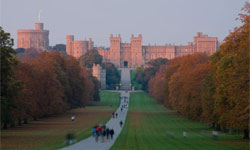 Windsor Castle: If you plan to visit England, you’ll discover that you could spend months visiting all the castles on this island. However, Windsor Castle is probably the most well known castle in the world, as – together with Buckingham Palace in London and Holyrood Palace in Edinburgh – it is one of the official residences of England’s Queen and the largest occupied castle in the world. This building and its complex have provided a home and fortress for royalty for over 900 years. Originally made of wood, the castle was built for William the Conqueror to guard the approach to London. The site sits above the River Thames, on the edge of a Saxon hunting ground and one day’s march from the Tower of London. Visitors can walk around the State Apartments, which are extensive suites of rooms at the heart of the working palace. Once you’re through with this castle, you can visit some of the top castles in Britain listed at the Travel Channel. Those castles all come highly recommended, but don’t forget to visit some of the smaller castles such as the one located in Dolwyddelan, Wales. This castle is a lovely place to visit along the road from Betws-y-Coed to the western coast and provides a chance to view Mount Snowden, the highest mountain in Wales.
Windsor Castle: If you plan to visit England, you’ll discover that you could spend months visiting all the castles on this island. However, Windsor Castle is probably the most well known castle in the world, as – together with Buckingham Palace in London and Holyrood Palace in Edinburgh – it is one of the official residences of England’s Queen and the largest occupied castle in the world. This building and its complex have provided a home and fortress for royalty for over 900 years. Originally made of wood, the castle was built for William the Conqueror to guard the approach to London. The site sits above the River Thames, on the edge of a Saxon hunting ground and one day’s march from the Tower of London. Visitors can walk around the State Apartments, which are extensive suites of rooms at the heart of the working palace. Once you’re through with this castle, you can visit some of the top castles in Britain listed at the Travel Channel. Those castles all come highly recommended, but don’t forget to visit some of the smaller castles such as the one located in Dolwyddelan, Wales. This castle is a lovely place to visit along the road from Betws-y-Coed to the western coast and provides a chance to view Mount Snowden, the highest mountain in Wales.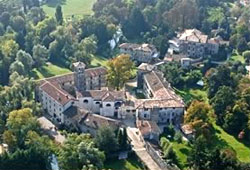 Castello di Strassoldo di Sopra: While there are more magnificent and famous Italian castles, this choice is far from the maddening tourist crowd. This castle is the ‘upper’ castle, which is located near the Castello di Strassoldo di Sotto (“lower” castle), and both castles are located in northeast Italy. Both castles also are privately owned by the Strassoldo family and have been in this family for almost one thousand years. Since they’re privately owned, they aren’t open to the public; however, the owners open their halls for two fascinating exhibits in the spring and fall each year. Additionally, important wedding banquets and other memorable events are personally organized by the owners. The castle’s splendid and fully furnished halls can host several hundred people, while the park can be used for open air buffets and wonderful photos. The owners of the Castello di Sopra have recently restored a fifteenth-century small house called “la Vicinia,” which they rent out overnight. This building and the castle are located in the heart of a lovely medieval village, surrounded by a centuries-old park that’s fed by spring waters.
Castello di Strassoldo di Sopra: While there are more magnificent and famous Italian castles, this choice is far from the maddening tourist crowd. This castle is the ‘upper’ castle, which is located near the Castello di Strassoldo di Sotto (“lower” castle), and both castles are located in northeast Italy. Both castles also are privately owned by the Strassoldo family and have been in this family for almost one thousand years. Since they’re privately owned, they aren’t open to the public; however, the owners open their halls for two fascinating exhibits in the spring and fall each year. Additionally, important wedding banquets and other memorable events are personally organized by the owners. The castle’s splendid and fully furnished halls can host several hundred people, while the park can be used for open air buffets and wonderful photos. The owners of the Castello di Sopra have recently restored a fifteenth-century small house called “la Vicinia,” which they rent out overnight. This building and the castle are located in the heart of a lovely medieval village, surrounded by a centuries-old park that’s fed by spring waters.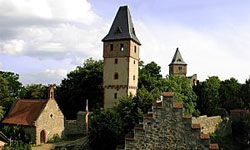 Frankenstein Castle: Darmstadt, Germany is home to the setting for Mary Shelley’s Gothic horror novel, Frankenstein. This castle was the 18th century home of Lord Konrad Dippel Von Frankenstein. There are many theories about Dippel, including one that he sold his soul for eternal life. In reality, Dippel was a highly controversial alchemist in whose laboratory the colour Prussian Blue was discovered. Maybe his enemies tried to ruin his reputation with the legend about the monster created in his laboratory. Visit Frankenstein Castle during Halloween to get the maximum scare factor, as an elaborate monster-themed theater show is performed, along with actors who lurk in the castle shadows. If this castle isn’t enough for you, you can visit a few other German castles that might tickle your luxury bones.
Frankenstein Castle: Darmstadt, Germany is home to the setting for Mary Shelley’s Gothic horror novel, Frankenstein. This castle was the 18th century home of Lord Konrad Dippel Von Frankenstein. There are many theories about Dippel, including one that he sold his soul for eternal life. In reality, Dippel was a highly controversial alchemist in whose laboratory the colour Prussian Blue was discovered. Maybe his enemies tried to ruin his reputation with the legend about the monster created in his laboratory. Visit Frankenstein Castle during Halloween to get the maximum scare factor, as an elaborate monster-themed theater show is performed, along with actors who lurk in the castle shadows. If this castle isn’t enough for you, you can visit a few other German castles that might tickle your luxury bones.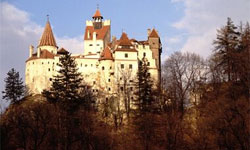 Bran Castle: This is another castle that the faint of heart might want to avoid! Commonly known as Dracula ‘s Castle, the Bran Castle was originally a stronghold built by the Knights of Teutonic Order in 1212. The first documentary attestation of the Bran Castle is the act issued on 19 November 1377, giving the Saxons of Kronstadt (Brasov) the privilege to build the Citadel. The building started in 1378 as a defense against Turks and later became a customs post on the pass between Transylvania and Walachia. From 1920 the castle became a royal residence until the expulsion of the royal family in 1948. Today it functions as a very attractive museum of medieval arts. The official Romanian site will provide you with the lowdown on this country’s castles, so be sure to visit that site if you plan to visit Romania.
Bran Castle: This is another castle that the faint of heart might want to avoid! Commonly known as Dracula ‘s Castle, the Bran Castle was originally a stronghold built by the Knights of Teutonic Order in 1212. The first documentary attestation of the Bran Castle is the act issued on 19 November 1377, giving the Saxons of Kronstadt (Brasov) the privilege to build the Citadel. The building started in 1378 as a defense against Turks and later became a customs post on the pass between Transylvania and Walachia. From 1920 the castle became a royal residence until the expulsion of the royal family in 1948. Today it functions as a very attractive museum of medieval arts. The official Romanian site will provide you with the lowdown on this country’s castles, so be sure to visit that site if you plan to visit Romania.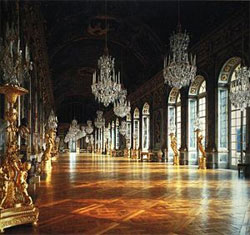 Château de Versailles: This castle complex is Louis XIV’s masterpiece, a structure so magnificent that the state treasury was almost depleted during its construction. Also known as the Palace of Versailles, and located now on the edge of Paris, this palace became home to French nobility during the seventeenth century. As the complex grew through four “building campaigns,” Versailles became the center of French government. Louis XIV lived at Versailles, and government offices, homes of thousands of courtiers and their retinues were built there, and nobles of a certain rank and position spent time each year at the court complex. Louis XIV’s attempt to centralize the French government succeeded, as few could match the ostentatious glamour represented by Versailles. Visitors now can visit this UNESCO World Heritage Site and view luxuries such as the Hall of Mirrors (pictured here) and the magnificent gardens among other features. The official Web site also contains a gallery and podcasts where individuals can learn about the castle before they actually visit. If this castle isn’t enough for you, then visit this list of French castle sites.
Château de Versailles: This castle complex is Louis XIV’s masterpiece, a structure so magnificent that the state treasury was almost depleted during its construction. Also known as the Palace of Versailles, and located now on the edge of Paris, this palace became home to French nobility during the seventeenth century. As the complex grew through four “building campaigns,” Versailles became the center of French government. Louis XIV lived at Versailles, and government offices, homes of thousands of courtiers and their retinues were built there, and nobles of a certain rank and position spent time each year at the court complex. Louis XIV’s attempt to centralize the French government succeeded, as few could match the ostentatious glamour represented by Versailles. Visitors now can visit this UNESCO World Heritage Site and view luxuries such as the Hall of Mirrors (pictured here) and the magnificent gardens among other features. The official Web site also contains a gallery and podcasts where individuals can learn about the castle before they actually visit. If this castle isn’t enough for you, then visit this list of French castle sites.
Middle East
The most significant castles in this region include those created by the European Crusaders who arrived in the Middle East during the Middle Ages to protect Jerusalem’s Holy Sepulcher. All total, eight crusades were carried out between 1096 and 1270, and an entire network of castles was built during this era that stretched from deserts in south Jordan to northern Asia Minor Mountains. You can gain access to a map that shows the sites of the Crusader castles located in the Levant.
What this map doesn’t show is the large percentage of castles built upon Byzantine architecture and with a strong influence from Armenian art. These castles often influenced European architecture, which borrowed upon this Greco-Armenian influence. On the other hand, an enterprising traveler could use this guide to soak in more than a handful of castles during a short trip. We chose five of the best castles within this region that we feel you shouldn’t miss – including one that was built recently.
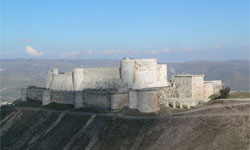 Krak des Chevaliers: T.E. Lawrence once described this castle, located in Syria, as “the best preserved and most wholly admirable castle in the world.” It is the easternmost of a chain of five castles intended to secure the Homs Gap, atop a 650-meter-high hill along the only route from Antioch to Beirut and the Mediterranean Sea. This castle and Beaufort, located in Lebanon as well, were the most important connection castles in the Middle East and they planed a major role in coastal defense for the Crusaders. In 1142 the castle was given by Raymond, Count of Tripoli, to the Knights Hospitallers, and it was they who, during the ensuing fifty years, remodeled and developed it as the most distinguished work of military architecture of its time. The castle remains one of the most complete pieces of military architecture dating from this period, and it holds some of the best preserved Crusader frescoes in the world. The complex contains two concentric walls that sandwich a ditch. The outer wall is an impressive three meters in width, and originally featured a dry moat and drawbridge and was designed to be able to withstand a siege lasting up to five years. Three of the eight round towers were built following the Crusades. Additionally, a chapel within this complex was later converted into a mosque.
Krak des Chevaliers: T.E. Lawrence once described this castle, located in Syria, as “the best preserved and most wholly admirable castle in the world.” It is the easternmost of a chain of five castles intended to secure the Homs Gap, atop a 650-meter-high hill along the only route from Antioch to Beirut and the Mediterranean Sea. This castle and Beaufort, located in Lebanon as well, were the most important connection castles in the Middle East and they planed a major role in coastal defense for the Crusaders. In 1142 the castle was given by Raymond, Count of Tripoli, to the Knights Hospitallers, and it was they who, during the ensuing fifty years, remodeled and developed it as the most distinguished work of military architecture of its time. The castle remains one of the most complete pieces of military architecture dating from this period, and it holds some of the best preserved Crusader frescoes in the world. The complex contains two concentric walls that sandwich a ditch. The outer wall is an impressive three meters in width, and originally featured a dry moat and drawbridge and was designed to be able to withstand a siege lasting up to five years. Three of the eight round towers were built following the Crusades. Additionally, a chapel within this complex was later converted into a mosque.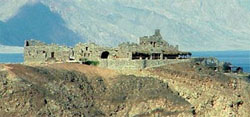 Castle Zaman: Castle Zaman is perched atop a desert cliff midway between Taba and Nuweiba in Sinai. The simple architecture provides amazing views over the Gulf of Aqaba, and into Israel, Jordan, Saudi Arabia, and Egypt. The exact site signifies a landmark on the ancient road that connected St. Catherine’s Monastery with Jerusalem. But, while a distant perspective might fool your eyes into believing this is an ancient ruin, Castle Zaman was built along a local theme to accommodate the contemporary tourist market. Used for honeymooners, parties, film or fashion shootings, the castle and its amenities are available for rent on a weekly or daily basis depending upon availability. Zaman’s private beach, with its pristine sand and crystal clear waters, is the only virgin beach left in the Taba and Nuweiba area.
Castle Zaman: Castle Zaman is perched atop a desert cliff midway between Taba and Nuweiba in Sinai. The simple architecture provides amazing views over the Gulf of Aqaba, and into Israel, Jordan, Saudi Arabia, and Egypt. The exact site signifies a landmark on the ancient road that connected St. Catherine’s Monastery with Jerusalem. But, while a distant perspective might fool your eyes into believing this is an ancient ruin, Castle Zaman was built along a local theme to accommodate the contemporary tourist market. Used for honeymooners, parties, film or fashion shootings, the castle and its amenities are available for rent on a weekly or daily basis depending upon availability. Zaman’s private beach, with its pristine sand and crystal clear waters, is the only virgin beach left in the Taba and Nuweiba area.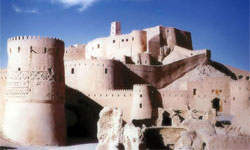 Arg-é Bam Castle: This enormous citadel, situated on the famous Silk Road, was built some time before 500 BCE and remained in use until 1850 CE. It is not known for certain why it was then abandoned. Located in Bam, Iran, this castle is the largest adobe building in the world. The entire building was a large fortress in whose heart the citadel itself was located, but because of the impressive look of the citadel, which forms the highest point, the entire fortress is named the Bam Citadel. It is listed by UNESCO as part of the World Heritage Site, but an earthquake in 2003 destroyed more than 80 percent of the buildings. However, since it is a World Heritage site, several countries – including Japan, Italy, and France – have joined forces to reconstruct the buildings. The World Bank has also granted a large sum of money to the restoration project.
Arg-é Bam Castle: This enormous citadel, situated on the famous Silk Road, was built some time before 500 BCE and remained in use until 1850 CE. It is not known for certain why it was then abandoned. Located in Bam, Iran, this castle is the largest adobe building in the world. The entire building was a large fortress in whose heart the citadel itself was located, but because of the impressive look of the citadel, which forms the highest point, the entire fortress is named the Bam Citadel. It is listed by UNESCO as part of the World Heritage Site, but an earthquake in 2003 destroyed more than 80 percent of the buildings. However, since it is a World Heritage site, several countries – including Japan, Italy, and France – have joined forces to reconstruct the buildings. The World Bank has also granted a large sum of money to the restoration project.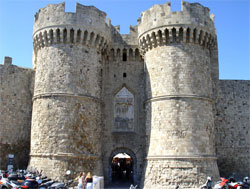 Rhodes Castle: The Island of Roses, or Rhodes, is famous for its historic Medieval town, great shopping, and the site of the Colossus of Rhodes. This ‘castle’ was built within the Old Town walls at the beginning of the 13th century CE by the Knights of St. John of Jerusalem. The building is comprised of 205 rooms and a conference area that hosts summits for European and world leaders. Today it attracts visitors from around the world as it houses the Archaeological Museum of Rhodes. Rhodes lies between Crete and the near East along the Aegean ocean. It is the largest of the Dodecanese islands and popular even among the Greeks as a holiday retreat. Rhodes holds about sixty thousand permanent residents, and it is the financial and cultural center of the southeastern Aegean area. The excellent tourist infrastructure that includes a wide variety of entertainment makes Rhodes a popular destination.
Rhodes Castle: The Island of Roses, or Rhodes, is famous for its historic Medieval town, great shopping, and the site of the Colossus of Rhodes. This ‘castle’ was built within the Old Town walls at the beginning of the 13th century CE by the Knights of St. John of Jerusalem. The building is comprised of 205 rooms and a conference area that hosts summits for European and world leaders. Today it attracts visitors from around the world as it houses the Archaeological Museum of Rhodes. Rhodes lies between Crete and the near East along the Aegean ocean. It is the largest of the Dodecanese islands and popular even among the Greeks as a holiday retreat. Rhodes holds about sixty thousand permanent residents, and it is the financial and cultural center of the southeastern Aegean area. The excellent tourist infrastructure that includes a wide variety of entertainment makes Rhodes a popular destination.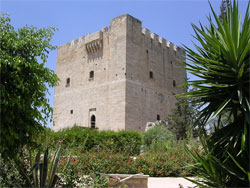 Kolossi Castle: The Kolossi Castle is stronghold located a few kilometers outside the city of Limassol on the island of Cyprus. It held a great strategic importance and contained production of sugar, one of Cyprus’ main exports in the Middle Ages. The original castle was built about 1210 by Frankish military when the land of Kolossi was given by King Hugh I to the Knights of the Order of St John of Jerusalem (Hospitallers). It is a stone fortress and the baseground was probably used as a store with two underground cisterns. You’ll enter the first floor via a suspended bridge, and on the south wall of one of the two lower rooms there is a wall painting representing the Crucifixion of Jesus Christ and the Blason Magnac, which is testimony to the royal devotional use of this room. The next room with the fireplace was likely to be the main dining and reception room. On the second floor there are two more rooms, which were used for lodging. On the roof of the monument, a scalding bowl and loopholes bring the thought of the visitor back to medieval sieges, along with the thought of boiling oil. Former inhabitants of this castle include Richard the Lionhearted and the Knights Templar.
Kolossi Castle: The Kolossi Castle is stronghold located a few kilometers outside the city of Limassol on the island of Cyprus. It held a great strategic importance and contained production of sugar, one of Cyprus’ main exports in the Middle Ages. The original castle was built about 1210 by Frankish military when the land of Kolossi was given by King Hugh I to the Knights of the Order of St John of Jerusalem (Hospitallers). It is a stone fortress and the baseground was probably used as a store with two underground cisterns. You’ll enter the first floor via a suspended bridge, and on the south wall of one of the two lower rooms there is a wall painting representing the Crucifixion of Jesus Christ and the Blason Magnac, which is testimony to the royal devotional use of this room. The next room with the fireplace was likely to be the main dining and reception room. On the second floor there are two more rooms, which were used for lodging. On the roof of the monument, a scalding bowl and loopholes bring the thought of the visitor back to medieval sieges, along with the thought of boiling oil. Former inhabitants of this castle include Richard the Lionhearted and the Knights Templar.
Asia
Like the Middle East, you can find maps that show castle locations throughout Asia. One map, which illustrates castle locations in Japan, clearly demonstrates the proliferation of these Oriental castles in the southern region of the islands. You also can learn about Japanese castles on a site written by a person who has visited over thirty Japanese castles. Maps for Chinese castles are few and far between, but this country’s marvelous architectural structures are beginning to enjoy global attention. Korea also holds a number of castles. Most of these buildings were created as fortresses with entire cities built within their enclosures, but many ‘castles’ in this region consist of temple-cities as well.
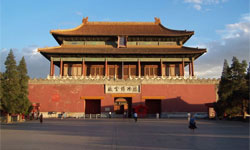 Forbidden City: As the seat of supreme power for over five centuries from 1416 to 1911, the Forbidden City in Beijing, China, contains four high towers on the four corners of the city wall. This is a fort that contains a city, and the walls are approximately one meter thick. Landscaped gardens and many buildings (whose nearly 10,000 rooms contain furniture and works of art), constitute a priceless testimony to Chinese civilization during the Ming and Qing dynasties. The Imperial Palace of the Qing Dynasty in Shenyang consists of 114 buildings constructed between 1625–26 and 1783. It contains an important library and testifies to the foundation of the last dynasty that ruled China before it expanded its power to the center of the country and moved the capital to Beijing. This palace then became auxiliary to the Imperial Palace in Beijing.
Forbidden City: As the seat of supreme power for over five centuries from 1416 to 1911, the Forbidden City in Beijing, China, contains four high towers on the four corners of the city wall. This is a fort that contains a city, and the walls are approximately one meter thick. Landscaped gardens and many buildings (whose nearly 10,000 rooms contain furniture and works of art), constitute a priceless testimony to Chinese civilization during the Ming and Qing dynasties. The Imperial Palace of the Qing Dynasty in Shenyang consists of 114 buildings constructed between 1625–26 and 1783. It contains an important library and testifies to the foundation of the last dynasty that ruled China before it expanded its power to the center of the country and moved the capital to Beijing. This palace then became auxiliary to the Imperial Palace in Beijing.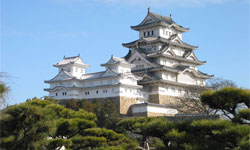 Himeji Castle: Himeji Castle was originally built in 1346 by Akamatsu Sadanori as a fortification against local shoguns. However, the castle has never seen battle, so it is the best preserved example of medieval castle architecture in all of Japan. Himeji is a hill castle that employs the surrounding geography as a bulwark against an enemy attack. The three moats – inner, middle, and outer – served as three lines of defense. The building has expanded over the centuries, and now stands intact on a hill in the center of Himeji City. It is surrounded by a tangled network of spiraling paths and high white walls and, in Japan, it is known as ‘White Heron Castle.’ In 1931 it was designated a national treasure. After several aborted attempts, restoration work began in 1956 and was completed in 1964. It 1993 it was put on the list of UNESCO World Cultural and Heritage Sites. The castle is said to be haunted by a servant girl named Okiku, who is said to have spurned a wealthy warlord’s attention in favor of her true love.
Himeji Castle: Himeji Castle was originally built in 1346 by Akamatsu Sadanori as a fortification against local shoguns. However, the castle has never seen battle, so it is the best preserved example of medieval castle architecture in all of Japan. Himeji is a hill castle that employs the surrounding geography as a bulwark against an enemy attack. The three moats – inner, middle, and outer – served as three lines of defense. The building has expanded over the centuries, and now stands intact on a hill in the center of Himeji City. It is surrounded by a tangled network of spiraling paths and high white walls and, in Japan, it is known as ‘White Heron Castle.’ In 1931 it was designated a national treasure. After several aborted attempts, restoration work began in 1956 and was completed in 1964. It 1993 it was put on the list of UNESCO World Cultural and Heritage Sites. The castle is said to be haunted by a servant girl named Okiku, who is said to have spurned a wealthy warlord’s attention in favor of her true love.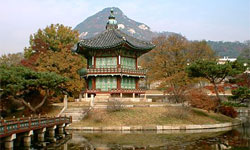 Gyeongbokgung or Gyeongbok Palace: While Seoul, Korea, contains five castles (or, palaces), this building may be the largest and most spectacular palace in Korea. It was originally built in 1395 by Korean architect Do-jeon. King Taejo then added on to the building to make it the main palace of the Joseon dynasty. The Japanese burned the building during an invasion in 1592, and it was left in ruins until King Gojong restored the area in 1868. At one time there were 330 buildings in the palace complex. Many of these are being reconstructed. It is said that the Korean alphabet, known as Hangeul, was created inside this palace during the fifteenth century under the reign of King Sejong.
Gyeongbokgung or Gyeongbok Palace: While Seoul, Korea, contains five castles (or, palaces), this building may be the largest and most spectacular palace in Korea. It was originally built in 1395 by Korean architect Do-jeon. King Taejo then added on to the building to make it the main palace of the Joseon dynasty. The Japanese burned the building during an invasion in 1592, and it was left in ruins until King Gojong restored the area in 1868. At one time there were 330 buildings in the palace complex. Many of these are being reconstructed. It is said that the Korean alphabet, known as Hangeul, was created inside this palace during the fifteenth century under the reign of King Sejong. Angkor Wat: The ruins of Angkor Wat are located amid forests and farmland to the north of the Great Lake (Tonle Sap) and south of the Kulen Hills, near modern day Siem Reap in Cambodia. Although not a castle per se, Angkor represents the seat of the Khmer empire that flourished in this region from approximately the ninth to fifteenth centuries. This period of rule began when the Khmer Hindu monarch Jayavarman II declared himself the “universal monarch” and “god-king” of Cambodia in about 802 CE until 1431 CE, when Thai invaders sacked the Khmer capital and caused its population to migrate south to the Phnom Penh area. The temples are now a UNESCO World Heritage Site, and the main building, Angkor Wat, is said to be the world’s largest single religious monument. Many of the temples at Angkor have been restored, and together they comprise the most significant site for Khmer architecture. With the help of satellite photographs and other techniques, an international team of researchers concluded in 2007 that Angkor Wat was the largest preindustrial city in the world, with an urban sprawl of 1,150 square miles. The closest rival would have been the Mayan city of Tikal in Guatemala, which was roughly fifty square miles in total size.
Angkor Wat: The ruins of Angkor Wat are located amid forests and farmland to the north of the Great Lake (Tonle Sap) and south of the Kulen Hills, near modern day Siem Reap in Cambodia. Although not a castle per se, Angkor represents the seat of the Khmer empire that flourished in this region from approximately the ninth to fifteenth centuries. This period of rule began when the Khmer Hindu monarch Jayavarman II declared himself the “universal monarch” and “god-king” of Cambodia in about 802 CE until 1431 CE, when Thai invaders sacked the Khmer capital and caused its population to migrate south to the Phnom Penh area. The temples are now a UNESCO World Heritage Site, and the main building, Angkor Wat, is said to be the world’s largest single religious monument. Many of the temples at Angkor have been restored, and together they comprise the most significant site for Khmer architecture. With the help of satellite photographs and other techniques, an international team of researchers concluded in 2007 that Angkor Wat was the largest preindustrial city in the world, with an urban sprawl of 1,150 square miles. The closest rival would have been the Mayan city of Tikal in Guatemala, which was roughly fifty square miles in total size.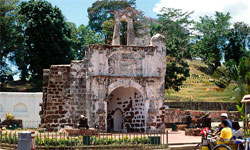 Malacca A’Famosa: When you go to the Web site linked here, you might wonder where the castle went. Well, for the most part, all that’s left of this sixteenth-century Portuguese fort is a tiny gate called the Porta de Santiago. In 1511 a Portuguese fleet arrived in what was then known as Melaka in Malaysia, under the command of Alfonso de Albuquerque. His forces attacked and successfully defeated the armies of the native Sultanate, and Albuquerque built a fortress near the sea. This commander believed that Melaka would become an important link between Portugal and China along the Spice Route. As Melaka’s population grew, the fort was expanded around 1586. The fort changed hands in 1641 when the Dutch drove the Portuguese out of Malaysia. The property changed hands once again in the early nineteenth century when the Dutch handed it over the British to prevent Melaka from falling into Napoleon’s hands. Knowing that they would need to hand the property back to the Dutch at the end of the Napoleonic wars, the British tried to make the entire city useless. Sir Stanford Raffles, Singapore’s founder, convinced the British to allow the population to remain, but all that remains of the buildings was the gate that stands today.
Malacca A’Famosa: When you go to the Web site linked here, you might wonder where the castle went. Well, for the most part, all that’s left of this sixteenth-century Portuguese fort is a tiny gate called the Porta de Santiago. In 1511 a Portuguese fleet arrived in what was then known as Melaka in Malaysia, under the command of Alfonso de Albuquerque. His forces attacked and successfully defeated the armies of the native Sultanate, and Albuquerque built a fortress near the sea. This commander believed that Melaka would become an important link between Portugal and China along the Spice Route. As Melaka’s population grew, the fort was expanded around 1586. The fort changed hands in 1641 when the Dutch drove the Portuguese out of Malaysia. The property changed hands once again in the early nineteenth century when the Dutch handed it over the British to prevent Melaka from falling into Napoleon’s hands. Knowing that they would need to hand the property back to the Dutch at the end of the Napoleonic wars, the British tried to make the entire city useless. Sir Stanford Raffles, Singapore’s founder, convinced the British to allow the population to remain, but all that remains of the buildings was the gate that stands today.
North America
Yes, Virginia – castles do exist in North America. Canada holds the largest castles on this continent, but there is something to be said about a castle that’s small enough to serve as a fishing camp. The following five castles represent a handful of approximately one hundred castles scattered throughout this continent.
 Chapultepec Castle: When you’re in Mexico City, Mexico, look up on the tallest point in the middle of Chapultepec Park. You’ll discover a building that has been used as a military academy, an imperial palace, an observatory, and a museum. It currently houses the Mexican National Museum of History, but you may recognize it as the 1996 film location for the Academy Award-nominated movie, William Shakespeare’s Romeo + Juliet starring Leonardo DiCaprio. It is the only castle in North America that was occupied by European sovereigns. Viceroy Bernardo de Gálvez ordered the construction of a country house on Chapultepec Hill in 1785. After a series of misfortunes and conspiricies, the municipal government of Mexico City purchased the building in 1806. The building went through more occupations and periods of disuse before President Lázaro Cárdenas decreed a law that established Chapultepec Castle as the seat of the National Museum of History (Museo Nacional de Historia) with the collections of the former National Museum of Archaeology, History and Ethnography.
Chapultepec Castle: When you’re in Mexico City, Mexico, look up on the tallest point in the middle of Chapultepec Park. You’ll discover a building that has been used as a military academy, an imperial palace, an observatory, and a museum. It currently houses the Mexican National Museum of History, but you may recognize it as the 1996 film location for the Academy Award-nominated movie, William Shakespeare’s Romeo + Juliet starring Leonardo DiCaprio. It is the only castle in North America that was occupied by European sovereigns. Viceroy Bernardo de Gálvez ordered the construction of a country house on Chapultepec Hill in 1785. After a series of misfortunes and conspiricies, the municipal government of Mexico City purchased the building in 1806. The building went through more occupations and periods of disuse before President Lázaro Cárdenas decreed a law that established Chapultepec Castle as the seat of the National Museum of History (Museo Nacional de Historia) with the collections of the former National Museum of Archaeology, History and Ethnography.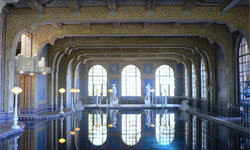 Hearst Castle: On the other side of the U.S. in California, you can find the home of newspaper baron William Randolph Hearst. Located halfway between San Francisco and Los Angeles, construction on this home began in 1919 on a 40,000 acre ranch that Hearst inherited from his father, George Hearst, and that was purchased originally in 1865. San Francisco architect Julia Morgan designed most of the buildings, but the estate was never completed during Hearst’s lifetime. He would tear down structures and rebuild them at a whim, making it difficult to complete the estate while Hearst had a hand in it. Additionally, the estate is a mix of architectural fancies that Hearst enjoyed on his European trips. The facade is modeled after a sixteenth-century Spanish cathedral, while the outdoor pool features an ancient Roman temple front that was transported wholesale from Europe and reconstructed at the site. The indoor pool, shown here, is modeled after Roman baths with gold mosaic tiles. The castle was donated by the Hearst Corporation to the state of California in 1957, and it is a Sate Historical Monument and a National Historic Landmark open for public tours.
Hearst Castle: On the other side of the U.S. in California, you can find the home of newspaper baron William Randolph Hearst. Located halfway between San Francisco and Los Angeles, construction on this home began in 1919 on a 40,000 acre ranch that Hearst inherited from his father, George Hearst, and that was purchased originally in 1865. San Francisco architect Julia Morgan designed most of the buildings, but the estate was never completed during Hearst’s lifetime. He would tear down structures and rebuild them at a whim, making it difficult to complete the estate while Hearst had a hand in it. Additionally, the estate is a mix of architectural fancies that Hearst enjoyed on his European trips. The facade is modeled after a sixteenth-century Spanish cathedral, while the outdoor pool features an ancient Roman temple front that was transported wholesale from Europe and reconstructed at the site. The indoor pool, shown here, is modeled after Roman baths with gold mosaic tiles. The castle was donated by the Hearst Corporation to the state of California in 1957, and it is a Sate Historical Monument and a National Historic Landmark open for public tours.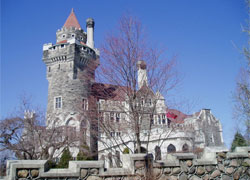 Casa Loma: Located in Toronto, Ontario, Canada, this castle was the former estate of Sir Henry Pellatt, a prominent Toronto financier, industrialist and military man. Construction on this castle began in 1911, and it took 300 men and nearly 3 years to complete at a price of over three million dollars. Pellatt enjoyed the castle for about one decade before he declared financial ruin. The city seized Casa Loma in 1933 for $27,303 in back taxes. While one critic called the mansion “a mixture of 17th century Scotland and 20th Century Fox,” many visitors tour the decorated suites, secret passages, an 800-foot tunnel, towers, stables, and five-acre estate gardens. The house was commissioned to Canadian architect. E.J. Lennox and, at 98 rooms, it was the largest private residence in North America upon completion. Many of the rooms were left unfinished, and today serve as the Regimental Museum for The Queen’s Own Rifles of Canada.
Casa Loma: Located in Toronto, Ontario, Canada, this castle was the former estate of Sir Henry Pellatt, a prominent Toronto financier, industrialist and military man. Construction on this castle began in 1911, and it took 300 men and nearly 3 years to complete at a price of over three million dollars. Pellatt enjoyed the castle for about one decade before he declared financial ruin. The city seized Casa Loma in 1933 for $27,303 in back taxes. While one critic called the mansion “a mixture of 17th century Scotland and 20th Century Fox,” many visitors tour the decorated suites, secret passages, an 800-foot tunnel, towers, stables, and five-acre estate gardens. The house was commissioned to Canadian architect. E.J. Lennox and, at 98 rooms, it was the largest private residence in North America upon completion. Many of the rooms were left unfinished, and today serve as the Regimental Museum for The Queen’s Own Rifles of Canada.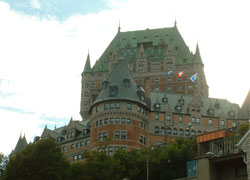 Frontenac Castle: The Frontenac Castle is actually a Fairmont Hotel that is located in Quebec City, Quebec, Canada, about one-half mile from Quebec’s parliament. Although the Fairmont Le Château Frontenac is actually a hotel, it is as symbolic to Quebec as the Eiffel Tower is to Paris. This Renaissance style castle was build in less than a century by the Canadian Pacific Railway company. With its castle-like architecture and turrets, Fairmont Le Château Frontenac plays a huge role in the heart of the city’s activities, and it has been designated a United Nations World Heritage Site. It may be difficult to book a room in 2008, as this year represents Quebec’s 400th anniversary.
Frontenac Castle: The Frontenac Castle is actually a Fairmont Hotel that is located in Quebec City, Quebec, Canada, about one-half mile from Quebec’s parliament. Although the Fairmont Le Château Frontenac is actually a hotel, it is as symbolic to Quebec as the Eiffel Tower is to Paris. This Renaissance style castle was build in less than a century by the Canadian Pacific Railway company. With its castle-like architecture and turrets, Fairmont Le Château Frontenac plays a huge role in the heart of the city’s activities, and it has been designated a United Nations World Heritage Site. It may be difficult to book a room in 2008, as this year represents Quebec’s 400th anniversary.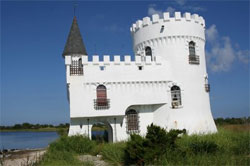 Fisherman’s Castle: Anyone who’s driven along I-10 between the Mississippi-Louisiana border and New Orleans in the United States has seen this small and simple castle sitting on the other side of Irish Bayou. Contractor Simon Villemarrette built the ‘home’ in 1981 and he based it upon a fourteenth-century French castle. He purposely built the castle with round turrets and with enough concrete to withstand 140 mph wind gusts. Unfortunately, Villemarrette died before he could occupy the home. This building did survive Hurricane Katrina in 2005 with little damage other than the chunks cut from the sides by flying debris. Jon Digman currently resides in the home as a caretaker, but it’s unknown who owns the home or what the future of this castle holds. The image shown here was taken in 2007, so it’s obvious that any damage created by Hurricane Katrina has been repaired. This little replica goes to show that any home can be a castle.
Fisherman’s Castle: Anyone who’s driven along I-10 between the Mississippi-Louisiana border and New Orleans in the United States has seen this small and simple castle sitting on the other side of Irish Bayou. Contractor Simon Villemarrette built the ‘home’ in 1981 and he based it upon a fourteenth-century French castle. He purposely built the castle with round turrets and with enough concrete to withstand 140 mph wind gusts. Unfortunately, Villemarrette died before he could occupy the home. This building did survive Hurricane Katrina in 2005 with little damage other than the chunks cut from the sides by flying debris. Jon Digman currently resides in the home as a caretaker, but it’s unknown who owns the home or what the future of this castle holds. The image shown here was taken in 2007, so it’s obvious that any damage created by Hurricane Katrina has been repaired. This little replica goes to show that any home can be a castle.
Around the World
The following castles aren’t as grand as those found in Europe or even in the Middle East or in Asia. But, for their owners and inhabitants, they represented all that was powerful, protective, and princely. And, the castle in Colombia, South America, would rival many European castles in sheer size. Many of the ‘castles’ located around the Caribbean were forts that housed a city complex complete with soldiers. On the other hand, some of the castles shown here were meant as private homes. Yet, these latter buildings are spacious enough to host large functions.
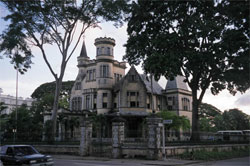 Stollmeyer’s Castle: Modeled after a wing of Balmoral Castle in Scotland, and created by the Scottish architect, Robert Gillies from the firm of Taylor and Gillies, this fantastic residence is definitely under Scottish influence. However, it’s located far from Scotland, as the home is located in Port-of-Spain in Trinidad. The wife of the original builder, Charles Fourier Stollmeyer, did not like the house, so it was passed to the Stollmeyer’s son, Conrad C. Stollmeyer. Mr. and Mrs. Conrad Stollmeyer lived at the house until their deaths in the 1960s, and the house then passed to the Stollmeyers’ only son, Dr. John Stollmeyer. In March, 1972, John Stollmeyer sold the home for $215,000 to Jesse Henry A. Mahabir, an insurance executive. The building was to be used for residential purposes only. The building was acquired from Mr. Mahabir by the Trinidad and Tobago Government in 1979. If you’re visiting Trinidad and Tobago, you might want to take in this home as well as six others that make up this country’s Magnificent Seven architectural treasures.
Stollmeyer’s Castle: Modeled after a wing of Balmoral Castle in Scotland, and created by the Scottish architect, Robert Gillies from the firm of Taylor and Gillies, this fantastic residence is definitely under Scottish influence. However, it’s located far from Scotland, as the home is located in Port-of-Spain in Trinidad. The wife of the original builder, Charles Fourier Stollmeyer, did not like the house, so it was passed to the Stollmeyer’s son, Conrad C. Stollmeyer. Mr. and Mrs. Conrad Stollmeyer lived at the house until their deaths in the 1960s, and the house then passed to the Stollmeyers’ only son, Dr. John Stollmeyer. In March, 1972, John Stollmeyer sold the home for $215,000 to Jesse Henry A. Mahabir, an insurance executive. The building was to be used for residential purposes only. The building was acquired from Mr. Mahabir by the Trinidad and Tobago Government in 1979. If you’re visiting Trinidad and Tobago, you might want to take in this home as well as six others that make up this country’s Magnificent Seven architectural treasures.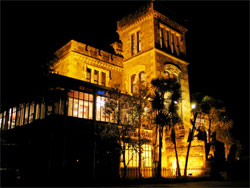 Larnach Castle: Visiting New Zealand? If you plan to spend any time in this area, then you’ll want to visit this country’s one and only castle. Australian-born William Larnach, merchant baron and politician, built this home for for his first wife in 1871. Over 200 workmen spent three years building the Castle shell and master European craftsmen spent a further 12 years embellishing the interior. Larnach spared no expense on this dream home, which features the finest materials from around the world. The building is the centerpiece of a 35-acre property atop a hill midway along the Otago Peninsula, eight miles from the city of Dunedin on the east cost of the country’s South Island. Still privately owned, the Barker family celebrated their 40th anniversary with Larnach Castle in 2007. Weddings, balls, official and formal functions and celebrations are held often in the home’s 3,000 square foot ballroom. But, be aware that this castle is haunted by both the first and second Mrs. Larnachs, and daughter Katie. The specter of Larnach himself might linger, as he shot himself in the head in 1898 when he learned that his young third wife was embroiled in an affair with one of Larnach’s sons from his first marriage.
Larnach Castle: Visiting New Zealand? If you plan to spend any time in this area, then you’ll want to visit this country’s one and only castle. Australian-born William Larnach, merchant baron and politician, built this home for for his first wife in 1871. Over 200 workmen spent three years building the Castle shell and master European craftsmen spent a further 12 years embellishing the interior. Larnach spared no expense on this dream home, which features the finest materials from around the world. The building is the centerpiece of a 35-acre property atop a hill midway along the Otago Peninsula, eight miles from the city of Dunedin on the east cost of the country’s South Island. Still privately owned, the Barker family celebrated their 40th anniversary with Larnach Castle in 2007. Weddings, balls, official and formal functions and celebrations are held often in the home’s 3,000 square foot ballroom. But, be aware that this castle is haunted by both the first and second Mrs. Larnachs, and daughter Katie. The specter of Larnach himself might linger, as he shot himself in the head in 1898 when he learned that his young third wife was embroiled in an affair with one of Larnach’s sons from his first marriage.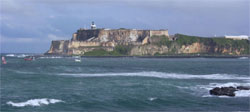 Castillo San Felipe del Morro: Over two million visitors a year explore theme windswept ramparts and pageways in this fortress/castle, where the history of 400 years of Spain in Puerto Rico comes alive. Begun in 1539 by Spanish settlers to defend the port of San Juan, El Morro’s architecture follows well established Spanish military fortification design principles. Similar Spanish fortifications from the seventeenth and eighteenth centuries can be seen on islands throughout the Caribbean and in Florida in the U.S. Named in honor of King Philip II of Spain, the Castillo was declared a World Heritage Site by the United Nations in 1983 and is part of San Juan National Historic Site.
Castillo San Felipe del Morro: Over two million visitors a year explore theme windswept ramparts and pageways in this fortress/castle, where the history of 400 years of Spain in Puerto Rico comes alive. Begun in 1539 by Spanish settlers to defend the port of San Juan, El Morro’s architecture follows well established Spanish military fortification design principles. Similar Spanish fortifications from the seventeenth and eighteenth centuries can be seen on islands throughout the Caribbean and in Florida in the U.S. Named in honor of King Philip II of Spain, the Castillo was declared a World Heritage Site by the United Nations in 1983 and is part of San Juan National Historic Site.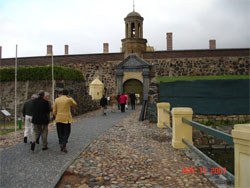 Castle of Good Hope: The Castle of Good Hope was built in Cape Town, South Africa, between between 1666 and 1679, which makes this castle complex the oldest surviving building in this region. The current pentagonal fortification replaced a small clay and timber fort built by Commander Jan van Riebeeck in 1652 upon establishing a maritime replenishment station art the Cape of Good Hope for the Dutch East India Company, better known as the VOC (Verenigde Oos-Indische Compagnie). In 1936 the Castle was declared a National Monument. As a result of an extensive, ongoing restoration and conservation program launched in the 1980’s, the Castle of Good Hope remains the best preserved of its kind built by the VOC in regions where it had interests. The Cape of Good Hope houses the regional headquarters of the South African Army in the Western Cape, the famous William Fehr Collection of historic artworks, the Castle Military Museum and ceremonial facilities for traditional Cape Regiments.
Castle of Good Hope: The Castle of Good Hope was built in Cape Town, South Africa, between between 1666 and 1679, which makes this castle complex the oldest surviving building in this region. The current pentagonal fortification replaced a small clay and timber fort built by Commander Jan van Riebeeck in 1652 upon establishing a maritime replenishment station art the Cape of Good Hope for the Dutch East India Company, better known as the VOC (Verenigde Oos-Indische Compagnie). In 1936 the Castle was declared a National Monument. As a result of an extensive, ongoing restoration and conservation program launched in the 1980’s, the Castle of Good Hope remains the best preserved of its kind built by the VOC in regions where it had interests. The Cape of Good Hope houses the regional headquarters of the South African Army in the Western Cape, the famous William Fehr Collection of historic artworks, the Castle Military Museum and ceremonial facilities for traditional Cape Regiments.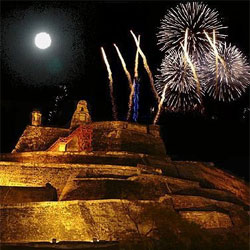 San Felipe Castle: Castillo de San Felipe, Cartagena, Colombia, South America, was founded in 1533. This forted castle is a walled city and a World Heritage site. It took slave labor over a century to build this fortress that dominates the landscape and that protected residents from pirates. The fortress is thought to be Spain’s most successful military engineering project in the Americas. Built from red brick and concrete, this citadel is designed so even if one part of the fortress fell to invaders (which never happened), the defenders could fire from another part. Its size is startling, and visitors begin to realize this building’s magnitude when they begin to explore the underground tunnel network.
San Felipe Castle: Castillo de San Felipe, Cartagena, Colombia, South America, was founded in 1533. This forted castle is a walled city and a World Heritage site. It took slave labor over a century to build this fortress that dominates the landscape and that protected residents from pirates. The fortress is thought to be Spain’s most successful military engineering project in the Americas. Built from red brick and concrete, this citadel is designed so even if one part of the fortress fell to invaders (which never happened), the defenders could fire from another part. Its size is startling, and visitors begin to realize this building’s magnitude when they begin to explore the underground tunnel network.
25 Simply Amazing Mosques
Posted in Features on January 11, 2008Considering that Cairo, Egypt alone contains over 1,000 mosques (Masjids), it wasn’t easy to pick the top twenty-five mosques in the world. But, when we added the words “amazing” and “largest” to the equation, we found some mosques that are worth a plane ticket to visit the sites. We also tried to provide a wide geographic area so that you can visit at least one of these architectural wonders during your lifetime. Mosques are places of worship, but they also lean toward education; therefore, you’ll find many mosques that also contain a madrasa (madrasah, madarasaa, medresa, madrassa), the Arabic word for any type of school, secular or religious. But, don’t expect to always find domes or minarets, features which have become symbolic of the Islam faith. You may discover that local culture often colored the architectural styles on many mosques.
The mosques listed below are listed in no particular order, and the numbering does not indicate that we favor one mosque over another or that they are listed in order of quality or even of size.
 Faisal Masjid, Islamabad, Pakistan: If you’re into visiting large buildings, the enormous Shah Faisal Masjid is your ticket to “big.” It’s the largest mosque in the world in terms of area. The building, which sits on approximately 1,89,705-sq. meters, has an area of 5,000 square meters. The building and its courtyard can hold about 300,000 worshippers. Situated at the foot of the Margalla Hills, the 88-meter-high minarets appear to be rockets on a huge launch pad, which provides a modern look. Yet, the main building area resembles a traditional Arab Bedouin’s tent, with its large triangular prayer hall. The designer, Turkish architect Vedat Dalokay (1927-1991), was chosen from an international competition, where architects from 17 countries submitted 43 proposals. King Faisal bin Abdul Aziz of Saudi Arabia approved of the design and location, and Saudi Arabia paid for the construction as a gift to the Pakistanis. The honor was returned when the mosque was named in honor of King Faisal. The masjid’s architecture is a departure from the long history of south Asian muslim architecture, however in some ways it makes a bridge between Arabic, Turkish and Pakistani Muslim architectural traditions. The complex houses the Islamic Research Centre, a library, museum, lecture hall, cafeteria, and the offices of the Islamic University faculty. If you plan to visit, dress conservatively with clothes that cover the body except for the hands and the head for men. Women need to wear a scarf to cover the hair.
Faisal Masjid, Islamabad, Pakistan: If you’re into visiting large buildings, the enormous Shah Faisal Masjid is your ticket to “big.” It’s the largest mosque in the world in terms of area. The building, which sits on approximately 1,89,705-sq. meters, has an area of 5,000 square meters. The building and its courtyard can hold about 300,000 worshippers. Situated at the foot of the Margalla Hills, the 88-meter-high minarets appear to be rockets on a huge launch pad, which provides a modern look. Yet, the main building area resembles a traditional Arab Bedouin’s tent, with its large triangular prayer hall. The designer, Turkish architect Vedat Dalokay (1927-1991), was chosen from an international competition, where architects from 17 countries submitted 43 proposals. King Faisal bin Abdul Aziz of Saudi Arabia approved of the design and location, and Saudi Arabia paid for the construction as a gift to the Pakistanis. The honor was returned when the mosque was named in honor of King Faisal. The masjid’s architecture is a departure from the long history of south Asian muslim architecture, however in some ways it makes a bridge between Arabic, Turkish and Pakistani Muslim architectural traditions. The complex houses the Islamic Research Centre, a library, museum, lecture hall, cafeteria, and the offices of the Islamic University faculty. If you plan to visit, dress conservatively with clothes that cover the body except for the hands and the head for men. Women need to wear a scarf to cover the hair. Great Mosque of Djenné, West Africa: Built entirely of ferey, or sun-baked mud bricks and covered with mud plaster, this mosque originally was built in the 13th century and was demolished in the year 1834. The only original portion of the building is an enclosure containing the graves of local leaders. The mosque you’ll see today was built at the beginning of the 20th century and completed about 1909. At that time, Djenné was part of the French West Africa colony, so the French may have offered political and economic support for the construction. The walls are between 41 cm and 61 cm thick, and bundles of palm branches are included in the structure to reduce cracking caused by frequent drastic changes in humidity and temperature. Although built in the Bani River basin, the Great Mosque was constructed on a raised platform with a surface area of 5625 m², which has protected the mosque from floods. The local residents have installed indoor plumbing and electrical wiring, but otherwise have resisted modernization in favor of historical integrity. Every year, Djenné’s mosque is repaired during a festival that is “at once awesome, messy, meticulous, and fun.” You can visit this mosque, which was named a UNESCO World Heritage Site in 1988, but don’t expect to enter the building unless you’re Muslim. The Great Mosque was closed to non-Muslims in 1996, after the French Vogue magazine offended local officials with a fashion photography shoot inside the building.
Great Mosque of Djenné, West Africa: Built entirely of ferey, or sun-baked mud bricks and covered with mud plaster, this mosque originally was built in the 13th century and was demolished in the year 1834. The only original portion of the building is an enclosure containing the graves of local leaders. The mosque you’ll see today was built at the beginning of the 20th century and completed about 1909. At that time, Djenné was part of the French West Africa colony, so the French may have offered political and economic support for the construction. The walls are between 41 cm and 61 cm thick, and bundles of palm branches are included in the structure to reduce cracking caused by frequent drastic changes in humidity and temperature. Although built in the Bani River basin, the Great Mosque was constructed on a raised platform with a surface area of 5625 m², which has protected the mosque from floods. The local residents have installed indoor plumbing and electrical wiring, but otherwise have resisted modernization in favor of historical integrity. Every year, Djenné’s mosque is repaired during a festival that is “at once awesome, messy, meticulous, and fun.” You can visit this mosque, which was named a UNESCO World Heritage Site in 1988, but don’t expect to enter the building unless you’re Muslim. The Great Mosque was closed to non-Muslims in 1996, after the French Vogue magazine offended local officials with a fashion photography shoot inside the building. The Grande Mosquée de Paris (“Great Mosque of Paris”): Unlike the previous mosque, this building is open to visitors, students, tourists, and Turkish bathers. You can enjoy a short tour of the building, its central courtyard, and its Moorish garden while listening to a brief history of the Islamic faith. The locals like to use the marble Turkish baths during the winter, and the Muslim Restaurant de la Mosquée de Paris, a cafe and restaurant that adjoins the mosque’s courtyard, serves North African cuisine such as couscous, tajine and sweet mint tea. This restaurant is popular with Parisians and tourists alike. Despite all this activity, the mosque remains an active place of worship for North Africans living in Paris, especially on Friday, the Muslim holy day, and during the holy month of Ramadan. This mosque is located in the Ve arrondissement, and it was built in 1922 as a symbol of gratitude from the French to North African Muslim tirailleurs who had fought against Germany during World War I. The pink marble mosque was built as a hybrid of Islamic styles (although it leans toward the mudéjar style), and the imposing structure features a large, sunken garden, fountains and a 33-meter high minaret. The internal courtyards, lined with Andalusian mosaics, are offset by dark eucalyptus and cedar trim. The Paris Grand Mosque oversees the affairs of around 400 of the 1,800 facilities described as mosques throughout France, which can include simple one-room structures. The head of the mosque, Dr. Dalil Boubakeur, described by the Le Monde newspaper as “the ideal Muslim,” is the most prominent Muslim in France and a friend of President Jacques Chirac. The mosque’s theological institute runs courses that it hopes will train a new generation of French-born imams, which is a hot topic in France. The courses are open to both Muslim and non-Muslim individuals.
The Grande Mosquée de Paris (“Great Mosque of Paris”): Unlike the previous mosque, this building is open to visitors, students, tourists, and Turkish bathers. You can enjoy a short tour of the building, its central courtyard, and its Moorish garden while listening to a brief history of the Islamic faith. The locals like to use the marble Turkish baths during the winter, and the Muslim Restaurant de la Mosquée de Paris, a cafe and restaurant that adjoins the mosque’s courtyard, serves North African cuisine such as couscous, tajine and sweet mint tea. This restaurant is popular with Parisians and tourists alike. Despite all this activity, the mosque remains an active place of worship for North Africans living in Paris, especially on Friday, the Muslim holy day, and during the holy month of Ramadan. This mosque is located in the Ve arrondissement, and it was built in 1922 as a symbol of gratitude from the French to North African Muslim tirailleurs who had fought against Germany during World War I. The pink marble mosque was built as a hybrid of Islamic styles (although it leans toward the mudéjar style), and the imposing structure features a large, sunken garden, fountains and a 33-meter high minaret. The internal courtyards, lined with Andalusian mosaics, are offset by dark eucalyptus and cedar trim. The Paris Grand Mosque oversees the affairs of around 400 of the 1,800 facilities described as mosques throughout France, which can include simple one-room structures. The head of the mosque, Dr. Dalil Boubakeur, described by the Le Monde newspaper as “the ideal Muslim,” is the most prominent Muslim in France and a friend of President Jacques Chirac. The mosque’s theological institute runs courses that it hopes will train a new generation of French-born imams, which is a hot topic in France. The courses are open to both Muslim and non-Muslim individuals. Centro Cultural Islámico Rey Fahd (King Fahd Islamic Cultural Center): Located in Buenos Aires, this mosque is the largest in South America. President Carlos Menem granted 34,000 m² of land for this mosque after a visit to Saudi Arabia in 1992. Construction began in 1998, and the center opened in 2000. The project cost about US$30 million, and it includes the mosque, library, two schools, and a park. Interestingly, Menem is Catholic, but he is of Syrian Muslim descent.Sporting traditional Arab mosque architecture with minarets and prayer hall, this building has been translated into a modern format. The Cultural Center is open to visitors for free tours twice a week in English and in Spanish. During this short tour, you’ll visit the gardens, the interior courtyard, the library and other spaces. The center offers classes in Koran and Arabic language and its library is open to the public daily. The mosque is striking at night, as both minarets are lit. The Cultural Center, which was named in honor of King Fahd bin Abdul Aziz Al Saud, is located near the polo fields in Palermo Gardens, where you can find the imposing statue of Sarmiento created in 1900 by the sculptor Auguste Rodin, the famous Rose Garden with its lake, and the Galileo Galilee Planetarium among other tourist delights.
Centro Cultural Islámico Rey Fahd (King Fahd Islamic Cultural Center): Located in Buenos Aires, this mosque is the largest in South America. President Carlos Menem granted 34,000 m² of land for this mosque after a visit to Saudi Arabia in 1992. Construction began in 1998, and the center opened in 2000. The project cost about US$30 million, and it includes the mosque, library, two schools, and a park. Interestingly, Menem is Catholic, but he is of Syrian Muslim descent.Sporting traditional Arab mosque architecture with minarets and prayer hall, this building has been translated into a modern format. The Cultural Center is open to visitors for free tours twice a week in English and in Spanish. During this short tour, you’ll visit the gardens, the interior courtyard, the library and other spaces. The center offers classes in Koran and Arabic language and its library is open to the public daily. The mosque is striking at night, as both minarets are lit. The Cultural Center, which was named in honor of King Fahd bin Abdul Aziz Al Saud, is located near the polo fields in Palermo Gardens, where you can find the imposing statue of Sarmiento created in 1900 by the sculptor Auguste Rodin, the famous Rose Garden with its lake, and the Galileo Galilee Planetarium among other tourist delights. The Lala Mustafa Pasha Mosque,Cyprus: If you think you’re seeing Gothic architecture in the image shown at right, then you would be correct. This building was originally known as the Saint Nicolas Cathedral and later as the Ayasofya (Saint Sophia) Mosque of Magusa, and it’s the largest medieval building in Famagusta, Cyprus. Built approximately between 1300CE and c.1400CE, the building initially was consecrated as a Christian cathedral and the western facade is remarkably similar to the Rheims Cathedral in France. The cathedral was converted into a mosque after the Ottoman Empire captured Famagusta in 1571, and it remains a mosque to this day. The upper parts of the mosque’s two towers suffered from earthquakes and were badly damaged during the Ottoman bombardments of 1571; they have never been repaired, but a minaret was added to one tower. The mosque was named after the Turkish leader who laid siege to the city in 1571.Other changes may have included the removal or covering of any depictions of saints or frescoes, as Islamic tradition excludes depictions of animals and humans from their religious architecture. Stained glass windows and the altar were also removed; although, since the area is prone to earthquakes, the removal of stained glass was probably more out of practicality than any other reason. A few tombs remain in the north aisle from the fourteenth century, and a guide will show you those tombs should you choose to visit. To the left of the facade is a small Ottoman tomb dating from 1700CE, and a small shrine. The old tree in front of the main door is said to have been planted in 1250, and is an East African fig tree. It is said to be the oldest living tree in Cyprus.
The Lala Mustafa Pasha Mosque,Cyprus: If you think you’re seeing Gothic architecture in the image shown at right, then you would be correct. This building was originally known as the Saint Nicolas Cathedral and later as the Ayasofya (Saint Sophia) Mosque of Magusa, and it’s the largest medieval building in Famagusta, Cyprus. Built approximately between 1300CE and c.1400CE, the building initially was consecrated as a Christian cathedral and the western facade is remarkably similar to the Rheims Cathedral in France. The cathedral was converted into a mosque after the Ottoman Empire captured Famagusta in 1571, and it remains a mosque to this day. The upper parts of the mosque’s two towers suffered from earthquakes and were badly damaged during the Ottoman bombardments of 1571; they have never been repaired, but a minaret was added to one tower. The mosque was named after the Turkish leader who laid siege to the city in 1571.Other changes may have included the removal or covering of any depictions of saints or frescoes, as Islamic tradition excludes depictions of animals and humans from their religious architecture. Stained glass windows and the altar were also removed; although, since the area is prone to earthquakes, the removal of stained glass was probably more out of practicality than any other reason. A few tombs remain in the north aisle from the fourteenth century, and a guide will show you those tombs should you choose to visit. To the left of the facade is a small Ottoman tomb dating from 1700CE, and a small shrine. The old tree in front of the main door is said to have been planted in 1250, and is an East African fig tree. It is said to be the oldest living tree in Cyprus. Islamic Center of America, Dearborn, Michigan: The Islamic Center of America is a mosque in Dearborn, Michigan, opened in 2005, that claims to be the largest in North America. It caters to mainly the Shi’a Muslim congregation; however, all Muslims may attend the mosque. The Islamic Center of America traces its origin to the 1940s, when Muslim immigrants from Lebanon and Syria began to settle in Detroit and brought young author and scholar, Imam Mohammed Jawad Chirri, from Lebanon as a religious leader in 1949. Chirri became the leader of the then-new Islamic Center Foundation Society in 1954, and this group decided they needed a new religious center. Chirri raised fund for the center in Egypt in 1959, and the Society purchased land from the Ford Motor Company. By 1963, the Islamic Center of America opened its doors for the first time. By 1967, the Center had already outgrown this space. Additional classrooms, an enlarged social hall, and a minaret were added to serve the growing membership. The 92,000-square-foot, $14 million building was completed on 12 May 2005. From the road, the face shows golden domes, Moorish arches, a stone exterior of desert tones, deep-green decorative tiles and two 110-foot-tall minarets topped with crescent moons.Chirri died in 1994, and his successor is the current Imam Sayed Hassan Al-Qazwini. Al-Qazwini founded the Young Muslim Association (YMA) in 1998, and affiliated this youth organization with the Islamic Center in Dearborn. This organization,one of the largest Muslim youth organizations in North America, is aimed at creating an environment in which Muslim youth can actively promote Islam and effectively channel their efforts. Al-Qazwini has also authored the book, “American Crescent,” where he pleads with Muslim Americans to integrate into American life while simultaneously deepening their identification as Muslims.
Islamic Center of America, Dearborn, Michigan: The Islamic Center of America is a mosque in Dearborn, Michigan, opened in 2005, that claims to be the largest in North America. It caters to mainly the Shi’a Muslim congregation; however, all Muslims may attend the mosque. The Islamic Center of America traces its origin to the 1940s, when Muslim immigrants from Lebanon and Syria began to settle in Detroit and brought young author and scholar, Imam Mohammed Jawad Chirri, from Lebanon as a religious leader in 1949. Chirri became the leader of the then-new Islamic Center Foundation Society in 1954, and this group decided they needed a new religious center. Chirri raised fund for the center in Egypt in 1959, and the Society purchased land from the Ford Motor Company. By 1963, the Islamic Center of America opened its doors for the first time. By 1967, the Center had already outgrown this space. Additional classrooms, an enlarged social hall, and a minaret were added to serve the growing membership. The 92,000-square-foot, $14 million building was completed on 12 May 2005. From the road, the face shows golden domes, Moorish arches, a stone exterior of desert tones, deep-green decorative tiles and two 110-foot-tall minarets topped with crescent moons.Chirri died in 1994, and his successor is the current Imam Sayed Hassan Al-Qazwini. Al-Qazwini founded the Young Muslim Association (YMA) in 1998, and affiliated this youth organization with the Islamic Center in Dearborn. This organization,one of the largest Muslim youth organizations in North America, is aimed at creating an environment in which Muslim youth can actively promote Islam and effectively channel their efforts. Al-Qazwini has also authored the book, “American Crescent,” where he pleads with Muslim Americans to integrate into American life while simultaneously deepening their identification as Muslims. Jumeirah Mosque, Dubai: Dubai is one of seven sheikhdoms that form the United Arab Emirates, and this city can trace its history back 5000 years. The Jumeirah Mosque, one of the largest sacred structures in Dubai, is built in the medieval Fatimid tradition from stone. This building is one of the most photographed sites in Dubai. Although non-Muslims are not allowed to enter Dubai mosques, the Sheikh Mohammed Centre for Cultural Understanding organizes visits to the Jumeirah Mosque for non-Muslims. This effort is aimed at promoting cultural understanding and first-hand experience with an insight to the Islamic religion. As with visiting most mosques, the tradition is to cover hair for women, and to dress conservatively and cover all parts of the body but for the hands, and for the heads of the men. The two minarets and the lacy domes on this building look spectacular at night (see photos), and they’re just as impressive in daylight.
Jumeirah Mosque, Dubai: Dubai is one of seven sheikhdoms that form the United Arab Emirates, and this city can trace its history back 5000 years. The Jumeirah Mosque, one of the largest sacred structures in Dubai, is built in the medieval Fatimid tradition from stone. This building is one of the most photographed sites in Dubai. Although non-Muslims are not allowed to enter Dubai mosques, the Sheikh Mohammed Centre for Cultural Understanding organizes visits to the Jumeirah Mosque for non-Muslims. This effort is aimed at promoting cultural understanding and first-hand experience with an insight to the Islamic religion. As with visiting most mosques, the tradition is to cover hair for women, and to dress conservatively and cover all parts of the body but for the hands, and for the heads of the men. The two minarets and the lacy domes on this building look spectacular at night (see photos), and they’re just as impressive in daylight. The Great Mosque of Xi’an, China: Like the Gothic mosque in Cyprus shown above, this first Chinese mosque reflects the Tang Dynasty architecture that was prevalent when this mosque was built during the 742CE (reign of Emperor Xuanzong, 685-762). Emperor Hongwu of the Ming Dynasty later renovated the mosque, but never added domes or minarets. The important feature in this type of architecture is its emphasis on symmetry, a contrast to the building’s surrounding gardens, which are a fine example of extreme asymmetry. This mosque is a fine example of Sino-Islamic architecture.This particular mosque is located near the Drum Tower (Gu Lou) on Huajue Lane of Xi’an (Sian), Shaanxi province, China, and it is one of the oldest and most renowned mosques in the country. The mosque was the religious center for Arab and Persian merchants who operated in China. The threads of commerce were established during the Tang Dynasty and the Silk Road was established. This trade route connected Xi’an to the Middle East and Europe, and opened China to the Western world. The 754 A.D. census showed that five thousand foreigners lived in the city; Turks, Iranians, Indians and others from along the Road, as well as Japanese, Koreans and Malays from the east. Many were missionaries, merchants or pilgrims, but every other occupation was also represented. Today’s Muslim community, which supports several mosques in this area, runs its own primary school, foods shops and restaurants, and continues to remain an integral part of Xi’an’s daily life.If you cannot visit this mosque, then visit this Web site about Islamic architecture. This site contains many pictures and detailed descriptions of the Great Mosque of Xi’an, as well as some history about the area. If you do visit, you might want to avoid the hours around noon, when – according to one tourist – animals are slaughtered and skinned in the courtyard.
The Great Mosque of Xi’an, China: Like the Gothic mosque in Cyprus shown above, this first Chinese mosque reflects the Tang Dynasty architecture that was prevalent when this mosque was built during the 742CE (reign of Emperor Xuanzong, 685-762). Emperor Hongwu of the Ming Dynasty later renovated the mosque, but never added domes or minarets. The important feature in this type of architecture is its emphasis on symmetry, a contrast to the building’s surrounding gardens, which are a fine example of extreme asymmetry. This mosque is a fine example of Sino-Islamic architecture.This particular mosque is located near the Drum Tower (Gu Lou) on Huajue Lane of Xi’an (Sian), Shaanxi province, China, and it is one of the oldest and most renowned mosques in the country. The mosque was the religious center for Arab and Persian merchants who operated in China. The threads of commerce were established during the Tang Dynasty and the Silk Road was established. This trade route connected Xi’an to the Middle East and Europe, and opened China to the Western world. The 754 A.D. census showed that five thousand foreigners lived in the city; Turks, Iranians, Indians and others from along the Road, as well as Japanese, Koreans and Malays from the east. Many were missionaries, merchants or pilgrims, but every other occupation was also represented. Today’s Muslim community, which supports several mosques in this area, runs its own primary school, foods shops and restaurants, and continues to remain an integral part of Xi’an’s daily life.If you cannot visit this mosque, then visit this Web site about Islamic architecture. This site contains many pictures and detailed descriptions of the Great Mosque of Xi’an, as well as some history about the area. If you do visit, you might want to avoid the hours around noon, when – according to one tourist – animals are slaughtered and skinned in the courtyard. Assyafaah Mosque, Singapore (The Modern Mosque): Designed by the Singapore-based Forum Architects for the Islamic Religious Council of Singapore (MUIS), this mosque breaks with tradition with its lack of a dome. Located on the north side of the island in a neighborhood filled with high-rise residential buildings, the architecture blends with its companion buildings in a statement that was intended by principal architect Tan Kok Hiang. He was concerned with the population’s ability to relate to each other “in a harmonious, or at the very least, tolerant manner,” so he planned the building with that leaning toward a building with no physical or visual ethnic or religious boundaries. Yet, it had to signal to the Muslim community that this building was, indeed, a mosque. So, a ten-story minaret built from rusted steel plates coated with colorless polyurethane marks the territory.Masjid Assyafaah opened in 2004, and it is the fifth mosque to be built under Phase III of the Mosque Building Fund program to serve the needs of the Muslim community in northern Singapore. It also acts as a replacement for the closure of two old mosques in the Sembawang area – Jumah Sembawang Mosque and Naval Base Mosque. This mosque can accommodate about 4,000 people at one time.
Assyafaah Mosque, Singapore (The Modern Mosque): Designed by the Singapore-based Forum Architects for the Islamic Religious Council of Singapore (MUIS), this mosque breaks with tradition with its lack of a dome. Located on the north side of the island in a neighborhood filled with high-rise residential buildings, the architecture blends with its companion buildings in a statement that was intended by principal architect Tan Kok Hiang. He was concerned with the population’s ability to relate to each other “in a harmonious, or at the very least, tolerant manner,” so he planned the building with that leaning toward a building with no physical or visual ethnic or religious boundaries. Yet, it had to signal to the Muslim community that this building was, indeed, a mosque. So, a ten-story minaret built from rusted steel plates coated with colorless polyurethane marks the territory.Masjid Assyafaah opened in 2004, and it is the fifth mosque to be built under Phase III of the Mosque Building Fund program to serve the needs of the Muslim community in northern Singapore. It also acts as a replacement for the closure of two old mosques in the Sembawang area – Jumah Sembawang Mosque and Naval Base Mosque. This mosque can accommodate about 4,000 people at one time. The Shah Mosque, Isfahan, Iran: A visit to the south side of Naghsh-i Jahan Square in Isfahan, Iran, will bring you face-to-face with The Shah Mosque – renamed to Imam Mosque after the Islamic Revolution of 1979. But, the mosque is also known as Masjid-e Shah, Masjid-e Imam, Royal Mosque, Mehedi Mosque, Masjid-i Shah. To simplify the matter, we’ll remain with The Shah Mosque, which is located roughly 210 miles (340 km) south of the capital city of Tehran on the north bank of the Zayandeh River.This mosque was built as the space for public worship in Shah Abbas’ new urban plan for Isfahan, but was not completed until the reign of his successor, Safi I. The reason it took so long to complete is that Abbas I built a whole new city. According to one description, it contained “162 mosques, 48 madrasahs, 1,802 commercial buildings, and 283 baths.” This mosque survives as one of the finest monuments to Islamic architecture. The portal is formal, and it addresses the square with a recessed domed vestibule that enters the apse of the north iwan at a 45-degree angle. This transition accommodates the angle between the median axis with which the portal is aligned, and the mosque’s orientation toward Mecca. Minarets are paired at both the entry portal and the south iwan (a mosque in which the prayer hall is an iwan or up to four iwans that surround a courtyard – it was the most popular style in the medieval period, and remained dominant in Iran). The southern dome, a bulbous form supported on a tall drum shape, is the largest and the only one decorated. When you visit this mosque, you’ll enjoy the wall painting and the vivid blue tiles. Once you’ve taken in the mosque, you can take tea in one of the teahouses located under the nearby bridges.
The Shah Mosque, Isfahan, Iran: A visit to the south side of Naghsh-i Jahan Square in Isfahan, Iran, will bring you face-to-face with The Shah Mosque – renamed to Imam Mosque after the Islamic Revolution of 1979. But, the mosque is also known as Masjid-e Shah, Masjid-e Imam, Royal Mosque, Mehedi Mosque, Masjid-i Shah. To simplify the matter, we’ll remain with The Shah Mosque, which is located roughly 210 miles (340 km) south of the capital city of Tehran on the north bank of the Zayandeh River.This mosque was built as the space for public worship in Shah Abbas’ new urban plan for Isfahan, but was not completed until the reign of his successor, Safi I. The reason it took so long to complete is that Abbas I built a whole new city. According to one description, it contained “162 mosques, 48 madrasahs, 1,802 commercial buildings, and 283 baths.” This mosque survives as one of the finest monuments to Islamic architecture. The portal is formal, and it addresses the square with a recessed domed vestibule that enters the apse of the north iwan at a 45-degree angle. This transition accommodates the angle between the median axis with which the portal is aligned, and the mosque’s orientation toward Mecca. Minarets are paired at both the entry portal and the south iwan (a mosque in which the prayer hall is an iwan or up to four iwans that surround a courtyard – it was the most popular style in the medieval period, and remained dominant in Iran). The southern dome, a bulbous form supported on a tall drum shape, is the largest and the only one decorated. When you visit this mosque, you’ll enjoy the wall painting and the vivid blue tiles. Once you’ve taken in the mosque, you can take tea in one of the teahouses located under the nearby bridges. Al-Azhar University and Mosque, Cairo, Egypt: In this city that holds over 1,000 mosques, this building is the one to see. It claims to be the oldest and foremost institution of higher learning for Muslims, but the Moroccan mosque that follows this one also makes that same claim. The mosque was built within two years after the foundation was laid in 969CE. The school of theology (Madrasah) connected with it was founded in 988 AD. Studies began in Al-Azhar in Ramadan by October 975CE, when Chief Justice Abul Hasan Ali ibn Al-No’man began to teach the book “Al-Ikhtisar,” on the Shiite jurisprudence. Towards the end of the Middle Ages, the school became affiliated with Sunni Islam, and it retains that orientation today. With that said, the university also offers secular classes in medicine and engineering.With a building this old, you can expect to see a variety of architectural styles incorporated within the gates, courtyard, and minarets. Latticework with a nod to gingerbread style creates a peaceful and quaint atmosphere for worshippers and students. Learn more about this building’s history before you visit.
Al-Azhar University and Mosque, Cairo, Egypt: In this city that holds over 1,000 mosques, this building is the one to see. It claims to be the oldest and foremost institution of higher learning for Muslims, but the Moroccan mosque that follows this one also makes that same claim. The mosque was built within two years after the foundation was laid in 969CE. The school of theology (Madrasah) connected with it was founded in 988 AD. Studies began in Al-Azhar in Ramadan by October 975CE, when Chief Justice Abul Hasan Ali ibn Al-No’man began to teach the book “Al-Ikhtisar,” on the Shiite jurisprudence. Towards the end of the Middle Ages, the school became affiliated with Sunni Islam, and it retains that orientation today. With that said, the university also offers secular classes in medicine and engineering.With a building this old, you can expect to see a variety of architectural styles incorporated within the gates, courtyard, and minarets. Latticework with a nod to gingerbread style creates a peaceful and quaint atmosphere for worshippers and students. Learn more about this building’s history before you visit. The University of Al-Karaouine and Mosque, Fes, Morocco: It wouldn’t be fair to offer the oldest institute for higher learning in Egypt (above) if the competition wasn’t listed as well. This university claims that it was founded in 859CE. No matter if the date is right or wrong, this university remains one of the leading Muslim spiritual and educational centers. For the record, it is listed as the oldest continuously operating institution in the Guinness Book of World Records. Unfortunately, non-Muslims are not permitted to enter the Kairaouine Mosque, but you can either peer through the gates or catch a good overview of the entire building from the roof of the Medersa el Attarin (Koranic school) if you can get in.While this site is more known for its university, this school would not exist if the mosque had not been built by Fatima Al-Fihri, the daughter of a wealthy merchant named Mohammed Al-Fihri. The mosque soon developed into a place for religious instruction and political discussion, gradually extending its education to a broad range of subjects, particularly the natural sciences. In 1957, King Mohammed V introduced math, physics, chemistry and foreign languages to its curriculum. This king also “jolted traditionalists” by setting up a female branch that year and 1,197 women were enrolled by 1960. While the school expanded, the mosque grew in stature as well. Within the past ten centuries, this mosque has become the largest in North Africa, with a capacity for more than 20,000 worshipers.Before you visit this mosque and university, you might want to read more about this building’s architectural qualities. While you cannot enter the mosque if you’re a non-Muslim, you can surely wander around portions of the university. Don’t get lost!
The University of Al-Karaouine and Mosque, Fes, Morocco: It wouldn’t be fair to offer the oldest institute for higher learning in Egypt (above) if the competition wasn’t listed as well. This university claims that it was founded in 859CE. No matter if the date is right or wrong, this university remains one of the leading Muslim spiritual and educational centers. For the record, it is listed as the oldest continuously operating institution in the Guinness Book of World Records. Unfortunately, non-Muslims are not permitted to enter the Kairaouine Mosque, but you can either peer through the gates or catch a good overview of the entire building from the roof of the Medersa el Attarin (Koranic school) if you can get in.While this site is more known for its university, this school would not exist if the mosque had not been built by Fatima Al-Fihri, the daughter of a wealthy merchant named Mohammed Al-Fihri. The mosque soon developed into a place for religious instruction and political discussion, gradually extending its education to a broad range of subjects, particularly the natural sciences. In 1957, King Mohammed V introduced math, physics, chemistry and foreign languages to its curriculum. This king also “jolted traditionalists” by setting up a female branch that year and 1,197 women were enrolled by 1960. While the school expanded, the mosque grew in stature as well. Within the past ten centuries, this mosque has become the largest in North Africa, with a capacity for more than 20,000 worshipers.Before you visit this mosque and university, you might want to read more about this building’s architectural qualities. While you cannot enter the mosque if you’re a non-Muslim, you can surely wander around portions of the university. Don’t get lost! The Sixty Dome Mosque, Bangladesh, India (also known as the Sixty Pillar Mosque, or Shait Gombuj Mosque): This mosque isn’t as garish as some, nor is it as spectacular as others. But, it’s old, and the architecture is one of the most impressive on the Indian continent. It was built by the general Ulugh Khan Jahan in the early 15th century, a military man who escaped Delhi after Timur sacked that city in 1398. The walls are thick and tapered in the Tughlaq style (native to Delhi, and a once popular style for tombs). It is decorated with terracotta and brick, with a hut-shaped roof that is supported by slender columns which culminate in numerous arches inside the mosque. Despite the site’s name, this roof sports over 77 domes and columns.
The Sixty Dome Mosque, Bangladesh, India (also known as the Sixty Pillar Mosque, or Shait Gombuj Mosque): This mosque isn’t as garish as some, nor is it as spectacular as others. But, it’s old, and the architecture is one of the most impressive on the Indian continent. It was built by the general Ulugh Khan Jahan in the early 15th century, a military man who escaped Delhi after Timur sacked that city in 1398. The walls are thick and tapered in the Tughlaq style (native to Delhi, and a once popular style for tombs). It is decorated with terracotta and brick, with a hut-shaped roof that is supported by slender columns which culminate in numerous arches inside the mosque. Despite the site’s name, this roof sports over 77 domes and columns. Jama Masjid Delhi, Delhi, India: Masjid-i-Jahan Numa means “the mosque commanding a view of the world,” and one reason for this moniker is the fact that the mosque stands on a five-foot tall platform. Three flights of steps lead to the mosque’s interior from the east, north, and south. The name Jama Masjid also is a reference to the weekly service observed on Friday (the yaum al-jum`a) at the mosque. This makes this mosque the principle Islamic center for India‘s Old Delhi, and also provides the mosque its nickname of the “Friday Mosque.” It was commissioned by the Mughal Emperor Shah Jahan and completed in the year 1656CE, and the expansive courtyard can hold up to twenty-five thousand worshippers. Its location at the busy Chandni Chowk also makes this mosque a popular place for tourists and locals alike.
Jama Masjid Delhi, Delhi, India: Masjid-i-Jahan Numa means “the mosque commanding a view of the world,” and one reason for this moniker is the fact that the mosque stands on a five-foot tall platform. Three flights of steps lead to the mosque’s interior from the east, north, and south. The name Jama Masjid also is a reference to the weekly service observed on Friday (the yaum al-jum`a) at the mosque. This makes this mosque the principle Islamic center for India‘s Old Delhi, and also provides the mosque its nickname of the “Friday Mosque.” It was commissioned by the Mughal Emperor Shah Jahan and completed in the year 1656CE, and the expansive courtyard can hold up to twenty-five thousand worshippers. Its location at the busy Chandni Chowk also makes this mosque a popular place for tourists and locals alike.
This mosque’s floor is finished in white and black marble that imitates the Muslim prayer mat. Additionally, a thin black marble border is marked for the worshippers. There are 899 such spaces marked on the floor. On your visit you might want to climb one of the smaller minarets in the rear of the mosque, where you can capture a birds-eye view of Old Delhi. You can view images of the floor and other delights that belong to this mosque at this gallery. Masjid Sultan Suriansyah, Indonesia: This mosque is the oldest mosque in South Kalimantan, dating about three centuries old (1526CE-1550CE). It was built during the reign of Sultan Suriansyah (Pangeran Samudera), the first Banjarese King to convert to Islam. The location is near the site of the palace complex that was destroyed by the colonial Dutch. Fortunately the mosque was spared, as it’s a fine example of pre-Islamic Banjar architecture. This building lacks the traditional dome and minarets, features that did not appear in Indonesia until the nineteenth century with the spread of a more orthodox Islamic tradition. The multi-level roofs shown here are very similar to Balinese Hindu temple pagodas and other traditional Indonesian architecture. What makes this mosque especially unique is the mihrab that has a separate roof from the main building.
Masjid Sultan Suriansyah, Indonesia: This mosque is the oldest mosque in South Kalimantan, dating about three centuries old (1526CE-1550CE). It was built during the reign of Sultan Suriansyah (Pangeran Samudera), the first Banjarese King to convert to Islam. The location is near the site of the palace complex that was destroyed by the colonial Dutch. Fortunately the mosque was spared, as it’s a fine example of pre-Islamic Banjar architecture. This building lacks the traditional dome and minarets, features that did not appear in Indonesia until the nineteenth century with the spread of a more orthodox Islamic tradition. The multi-level roofs shown here are very similar to Balinese Hindu temple pagodas and other traditional Indonesian architecture. What makes this mosque especially unique is the mihrab that has a separate roof from the main building. Great Mosque of Samarra, Iraq: This mosque was built in the 9th century, commissioned in 848CE and completed in 52 years by the Abbasid caliph Al-Mutawakkil who reigned (in Samarra) from 847 until 861. At one time, this mosque also claimed the right to the largest mosque in the world, as its minaret (the Malwiya or al-Malwiya Tower) is 52 meters high and thirty-three meters wide at the base with a spiral ramp. This spiral is so respected that it’s a feature on Iraqi banknotes.In a list of Al-Mutawakkil’s building projects, the then-new “Congregational Mosque” and up to 20 palaces are mentioned, so this leader seems to have been fond of architecture. The mosque was originally designed to hold eighty thousand worshippers. The baked brick walls surround an area that is 240 meters in length, 158 meters wide, and 10 meters high, and the walls were paneled with dark blue glass mosaics.The minaret was featured in the U.S. Department of Defense’s Archaeology Awareness playing cards that were designed to educate U.S. troops about cultural heritage while on active service in Iraq and Afghanistan. Unfortunately, on 1 April 2005, the top of the Malwiya minaret was damaged by a bomb. Insurgents reportedly attacked the tower because U.S. troops had been using it as a lookout position. Ironically, Iraq’s antiquities officials also had expressed concern that US soldiers had caused significant damage to historic sites in Samarra, including the walls of an ancient palace. Despite the war in Iraq, this mosque remains a popular tourist site.
Great Mosque of Samarra, Iraq: This mosque was built in the 9th century, commissioned in 848CE and completed in 52 years by the Abbasid caliph Al-Mutawakkil who reigned (in Samarra) from 847 until 861. At one time, this mosque also claimed the right to the largest mosque in the world, as its minaret (the Malwiya or al-Malwiya Tower) is 52 meters high and thirty-three meters wide at the base with a spiral ramp. This spiral is so respected that it’s a feature on Iraqi banknotes.In a list of Al-Mutawakkil’s building projects, the then-new “Congregational Mosque” and up to 20 palaces are mentioned, so this leader seems to have been fond of architecture. The mosque was originally designed to hold eighty thousand worshippers. The baked brick walls surround an area that is 240 meters in length, 158 meters wide, and 10 meters high, and the walls were paneled with dark blue glass mosaics.The minaret was featured in the U.S. Department of Defense’s Archaeology Awareness playing cards that were designed to educate U.S. troops about cultural heritage while on active service in Iraq and Afghanistan. Unfortunately, on 1 April 2005, the top of the Malwiya minaret was damaged by a bomb. Insurgents reportedly attacked the tower because U.S. troops had been using it as a lookout position. Ironically, Iraq’s antiquities officials also had expressed concern that US soldiers had caused significant damage to historic sites in Samarra, including the walls of an ancient palace. Despite the war in Iraq, this mosque remains a popular tourist site. Masjid al-Haram, “The Sacred Mosque,” Makkah al-Mukkaramah: If you’re going to go on a serious mosque search, you cannot miss the largest mosque in Islam, situated in the city of Mecca (now recognized as Makkah al-Mukkaramah). The structure currently covers an area of 356,800 square meters, which includes both indoor and outdoor praying spaces. It can accommodate up to four million worshippers during the Hajj period. This building surrounds the Ka’aba, the place where all Muslims turn towards five times each day in prayer. This Ka’aba is a cube-shaped structure that is believed to have been built by Abraham in God’s honor, so it is considered the holiest place on earth for the Muslims. Some believe this mosque was erected on the original site of a sanctuary established by the first Prophet, Adam.Every Muslim who can afford it is required to make a pilgrimage to Mecca as one of the Five Pillars of Faith. Every year, approximately three million individuals gather for this Hajj during the Muslim month of Dhu’l-Hijja (which varies according to the Muslim calendar). Many more worshippers perform the minor pilgrimage, or Umrah, at various times throughout the year. Dhu’l-Hijja is not the time for non-Muslims to visit this area, as they are strictly prohibited from entering Mecca and Medina. Roadblocks are stationed along roads leading to the city. So you might conduct some research on current dates for this event before you visit.
Masjid al-Haram, “The Sacred Mosque,” Makkah al-Mukkaramah: If you’re going to go on a serious mosque search, you cannot miss the largest mosque in Islam, situated in the city of Mecca (now recognized as Makkah al-Mukkaramah). The structure currently covers an area of 356,800 square meters, which includes both indoor and outdoor praying spaces. It can accommodate up to four million worshippers during the Hajj period. This building surrounds the Ka’aba, the place where all Muslims turn towards five times each day in prayer. This Ka’aba is a cube-shaped structure that is believed to have been built by Abraham in God’s honor, so it is considered the holiest place on earth for the Muslims. Some believe this mosque was erected on the original site of a sanctuary established by the first Prophet, Adam.Every Muslim who can afford it is required to make a pilgrimage to Mecca as one of the Five Pillars of Faith. Every year, approximately three million individuals gather for this Hajj during the Muslim month of Dhu’l-Hijja (which varies according to the Muslim calendar). Many more worshippers perform the minor pilgrimage, or Umrah, at various times throughout the year. Dhu’l-Hijja is not the time for non-Muslims to visit this area, as they are strictly prohibited from entering Mecca and Medina. Roadblocks are stationed along roads leading to the city. So you might conduct some research on current dates for this event before you visit. Jami-Ul-Alfar Mosque, Colombo, Sri Lanka: This mosque, one of the oldest in Colombo, remains a tourist landmark in this capital city simply for its striped red and white decorative architecture. Located at Second Cross Street in the Pettah Bazaar area, Jami-Ul-Alfar Mosque was completed in 1909. H.L. Saibo Lebbe was named the architect for this building in 1908, and he completed the project in one year. Some claim that the Jami Ul Alfar mosque was recognized as the Colombo landmark by sailors during the twentieth century.As a tourist, you may be treated as graciously as this person, who shares his photographs of the inside of the mosque online. But, if you can’t make it to Sri Lanka, you can try to visit the Masjid Jamek in Kuala Lumpur. This mosque was also completed in 1909, it’s one of the oldest mosques in the area, and it bears a slight resemblance to the Sri Lanka mosque.
Jami-Ul-Alfar Mosque, Colombo, Sri Lanka: This mosque, one of the oldest in Colombo, remains a tourist landmark in this capital city simply for its striped red and white decorative architecture. Located at Second Cross Street in the Pettah Bazaar area, Jami-Ul-Alfar Mosque was completed in 1909. H.L. Saibo Lebbe was named the architect for this building in 1908, and he completed the project in one year. Some claim that the Jami Ul Alfar mosque was recognized as the Colombo landmark by sailors during the twentieth century.As a tourist, you may be treated as graciously as this person, who shares his photographs of the inside of the mosque online. But, if you can’t make it to Sri Lanka, you can try to visit the Masjid Jamek in Kuala Lumpur. This mosque was also completed in 1909, it’s one of the oldest mosques in the area, and it bears a slight resemblance to the Sri Lanka mosque. The Ulugh Beg Madrasa, Uzbekistan: This mosque looks like a large piece of candy, with all the multi-colored tiles that are installed on its façade. This variegated decoration was executed in hazarbaf brickwork, haft rangi tiles and mosaic faience, and it covers every exterior surface. Marble is used to form dados and moldings. This mosque is the sole survivor of an entire complex that included several mosques, caravanserais and a bazaar. Also known as “Ulugbek Madrassah,” this building was erected in 1417, as the inscription on the door’s bronze plate claims.Like the Chinese mosque shown previously, this area benefited from the Silk Road culture, and a viewer can only imagine a whole complex of buildings that were just as ornate as this mosque. The mosque is named for Ulugh Beg, a Timurid ruler, astronomer, mathematician and sultan. He was interested in learning, so this site received scholars, both religious and secular, during the Timurid period. The building welcomed worshippers until the late seventeenth century, when it became a grain storage for more than a century. The building was reclaimed for education in the early twentieth century.
The Ulugh Beg Madrasa, Uzbekistan: This mosque looks like a large piece of candy, with all the multi-colored tiles that are installed on its façade. This variegated decoration was executed in hazarbaf brickwork, haft rangi tiles and mosaic faience, and it covers every exterior surface. Marble is used to form dados and moldings. This mosque is the sole survivor of an entire complex that included several mosques, caravanserais and a bazaar. Also known as “Ulugbek Madrassah,” this building was erected in 1417, as the inscription on the door’s bronze plate claims.Like the Chinese mosque shown previously, this area benefited from the Silk Road culture, and a viewer can only imagine a whole complex of buildings that were just as ornate as this mosque. The mosque is named for Ulugh Beg, a Timurid ruler, astronomer, mathematician and sultan. He was interested in learning, so this site received scholars, both religious and secular, during the Timurid period. The building welcomed worshippers until the late seventeenth century, when it became a grain storage for more than a century. The building was reclaimed for education in the early twentieth century. Dublin Mosque, Ireland: This is another mosque that reflects the regional culture, as this place of worship is situated in what used to be a house in Dublin. This mosque, which was opened in 1983, owes its current status to a group of Islamic students who arrived in Dublin in the early 1950s to study. They formed the first Islamic Society in 1959, and a decade later the Society began to petition for funds for a building. They first purchased a four-story house on Harrington Street, but a rise in the number of worshippers forced the group to find a new building. In 1983, this current building, a house on South Circular Road, Dublin 8, was purchased and the other mosque was sold.The Islamic Foundation of Ireland uses this building as its headquarters, and this society represents all Muslims in Ireland. There are other societies in various Irish counties that also service the Muslim community. The current number of Muslims in Ireland totals about 1,300.
Dublin Mosque, Ireland: This is another mosque that reflects the regional culture, as this place of worship is situated in what used to be a house in Dublin. This mosque, which was opened in 1983, owes its current status to a group of Islamic students who arrived in Dublin in the early 1950s to study. They formed the first Islamic Society in 1959, and a decade later the Society began to petition for funds for a building. They first purchased a four-story house on Harrington Street, but a rise in the number of worshippers forced the group to find a new building. In 1983, this current building, a house on South Circular Road, Dublin 8, was purchased and the other mosque was sold.The Islamic Foundation of Ireland uses this building as its headquarters, and this society represents all Muslims in Ireland. There are other societies in various Irish counties that also service the Muslim community. The current number of Muslims in Ireland totals about 1,300. The Saint Petersburg Mosque, Russia: When this mosque opened in 1913, it was the largest mosque in Europe with minarets at 48 meters in height and the dome rising 39 meters high. But, it still operates as the largest Muslim center in this Russian city, as it can accomodate up to five thousand worshippers who are separated by gender during a worship service. The mosque was built to commemorate the twenty-fifth anniversary of Abdul Ahat Khan, Emir of Bukhara (Turkistan), and a founding stone was laid in 1910 in his honor. Originally, there were many opponents to the construction of this building, but Nicholas II authorized the sale of land to the Muslim population in St. Petersburg in 1907. The announced architectural contest was won by architects Krichinsky, Vasiliev and Gogen.The walls in this building are faced with dark gray granite, which is a somber choice when compared to some snow-white mosques. The dome and minarets are decorated with multi-colored tiles and the facade is adorned with quotes from the Koran. The St. Petersburg Mosque closed and used as a warehouse during World War II, but the building was returned to the Muslim worshippers in 1956 at the request of the first Indonesian President, Soekarno. Major restorations were made to the building in 1980.
The Saint Petersburg Mosque, Russia: When this mosque opened in 1913, it was the largest mosque in Europe with minarets at 48 meters in height and the dome rising 39 meters high. But, it still operates as the largest Muslim center in this Russian city, as it can accomodate up to five thousand worshippers who are separated by gender during a worship service. The mosque was built to commemorate the twenty-fifth anniversary of Abdul Ahat Khan, Emir of Bukhara (Turkistan), and a founding stone was laid in 1910 in his honor. Originally, there were many opponents to the construction of this building, but Nicholas II authorized the sale of land to the Muslim population in St. Petersburg in 1907. The announced architectural contest was won by architects Krichinsky, Vasiliev and Gogen.The walls in this building are faced with dark gray granite, which is a somber choice when compared to some snow-white mosques. The dome and minarets are decorated with multi-colored tiles and the facade is adorned with quotes from the Koran. The St. Petersburg Mosque closed and used as a warehouse during World War II, but the building was returned to the Muslim worshippers in 1956 at the request of the first Indonesian President, Soekarno. Major restorations were made to the building in 1980. The Mezquita, Córdoba, Spain: Construction on the Mezquita (Spanish for “mosque” or Muslim “masjid”) began in the sixth century BCE as a cathedral. Beginning at about starting in 784CE, the building began its incarnation into a Muslim mosque under the Moors. At that time it was known as the Aljama Mosque and – at that time – it was the second largest mosque in the world, taking over two centuries to complete its transformation. During this era, Córdoba was the largest, most prosperous cities of Europe, outshining Byzantium and Baghdad in science, culture and the arts. When Fernando III captured Córdoba in 1236CE, the mosque was once again converted to a cathedral.Now you can visit this expansive mosque/cathedral for a few Euro. The alternating brick and stone arches and the more than 850 colored granite jasper and marble pillars that seem to reach across time and space will take your breath away. The Moorish, Baroque and Gothic architectural mix is something not to be missed. Artists and architects continued to add to the existing structure until the late 18th century, making the Mezquita an outstanding architectural oddity.
The Mezquita, Córdoba, Spain: Construction on the Mezquita (Spanish for “mosque” or Muslim “masjid”) began in the sixth century BCE as a cathedral. Beginning at about starting in 784CE, the building began its incarnation into a Muslim mosque under the Moors. At that time it was known as the Aljama Mosque and – at that time – it was the second largest mosque in the world, taking over two centuries to complete its transformation. During this era, Córdoba was the largest, most prosperous cities of Europe, outshining Byzantium and Baghdad in science, culture and the arts. When Fernando III captured Córdoba in 1236CE, the mosque was once again converted to a cathedral.Now you can visit this expansive mosque/cathedral for a few Euro. The alternating brick and stone arches and the more than 850 colored granite jasper and marble pillars that seem to reach across time and space will take your breath away. The Moorish, Baroque and Gothic architectural mix is something not to be missed. Artists and architects continued to add to the existing structure until the late 18th century, making the Mezquita an outstanding architectural oddity. The Ibrahim-al-Ibrahim Mosque, Gibraltar: If you’re sightseeing in Gibraltar on the southernmost tip of the Iberian Peninsula overlooking the Strait of Gibraltar, it would be difficult to miss this statuesque mosque. Also known as the King Fahd bin Abdulaziz al-Saud Mosque or the Mosque of the Custodian of the Two Holy Mosques, this building is located at Europa Point at the southern tip of Gibraltar . The mosque was a gift from King Fahd of Saudi Arabia to the 2000 Muslim inhabitants in Gibraltar . It took two years to build at a cost of about five million pounds. The building, which was completed in August 1997, contains a school, library, and lecture hall.This mosque has an underground tank believed to have existed since the time of the Moors (742CE – 1300CE), located on a flat ground next to the building. The area was known as Nun’s Well, and according to theory, received that name because the nuns from the Shrine of Our Lady of Europa, also located in Gibraltar, could have used it during early times.
The Ibrahim-al-Ibrahim Mosque, Gibraltar: If you’re sightseeing in Gibraltar on the southernmost tip of the Iberian Peninsula overlooking the Strait of Gibraltar, it would be difficult to miss this statuesque mosque. Also known as the King Fahd bin Abdulaziz al-Saud Mosque or the Mosque of the Custodian of the Two Holy Mosques, this building is located at Europa Point at the southern tip of Gibraltar . The mosque was a gift from King Fahd of Saudi Arabia to the 2000 Muslim inhabitants in Gibraltar . It took two years to build at a cost of about five million pounds. The building, which was completed in August 1997, contains a school, library, and lecture hall.This mosque has an underground tank believed to have existed since the time of the Moors (742CE – 1300CE), located on a flat ground next to the building. The area was known as Nun’s Well, and according to theory, received that name because the nuns from the Shrine of Our Lady of Europa, also located in Gibraltar, could have used it during early times. Dar al-Islam Mosque, New Mexico: If you happen to visit the hills of the Rio Chama Valley, you’ll find a stunning structure of adobe topped by a softly sculpted dome that seems very much at home in its high-desert environment. You might think Georgia O’Keefe, or even The Alamo. But, you’d be far from the mark, as you’d be admiring an Islamic mosque built in 1981 by renowned Egyptian architect Hassan Fathi, the mosque resembles buildings of the same stature in north and West Africa. Dar al-Islam was originally intended to serve as the centerpiece of a community of schools and living quarters for North American Muslims. The planned village doesn’t exist, but the mosque has developed programs in connection with educational institutions to promote a better understanding of Islam. Retreats, study groups, and workshops allow Muslims and non-Muslims to study with visiting scholars. In the valley below sits the natural wonder known as Plaza Blanca, also immortalized as “The White Place in the Shadow” in a 1942 painting by O’Keeffe (so you weren’t too far off the mark, after all!).Situated on 1,600 acres, the mosque and adjoining madrassah includes vaulted ceilings, domes, archways, gardens, courtyards, and a library. The Dar al-Islam community of several dedicated families consists of educators, artists, poets, and writers who want to “build bridges between Muslims and the wider North American community by communicating the deep spirituality and beauty of the Islamic tradition by living it.” The Dar al Islam Foundation sponsors many projects across the continent to bring Muslims and non-Muslims together to discuss Islam and other related issues. Among its most popular programs is the yearly Teachers’ Institute, which has brought together over 200 educators from the United States and Canada to learn about Islam.
Dar al-Islam Mosque, New Mexico: If you happen to visit the hills of the Rio Chama Valley, you’ll find a stunning structure of adobe topped by a softly sculpted dome that seems very much at home in its high-desert environment. You might think Georgia O’Keefe, or even The Alamo. But, you’d be far from the mark, as you’d be admiring an Islamic mosque built in 1981 by renowned Egyptian architect Hassan Fathi, the mosque resembles buildings of the same stature in north and West Africa. Dar al-Islam was originally intended to serve as the centerpiece of a community of schools and living quarters for North American Muslims. The planned village doesn’t exist, but the mosque has developed programs in connection with educational institutions to promote a better understanding of Islam. Retreats, study groups, and workshops allow Muslims and non-Muslims to study with visiting scholars. In the valley below sits the natural wonder known as Plaza Blanca, also immortalized as “The White Place in the Shadow” in a 1942 painting by O’Keeffe (so you weren’t too far off the mark, after all!).Situated on 1,600 acres, the mosque and adjoining madrassah includes vaulted ceilings, domes, archways, gardens, courtyards, and a library. The Dar al-Islam community of several dedicated families consists of educators, artists, poets, and writers who want to “build bridges between Muslims and the wider North American community by communicating the deep spirituality and beauty of the Islamic tradition by living it.” The Dar al Islam Foundation sponsors many projects across the continent to bring Muslims and non-Muslims together to discuss Islam and other related issues. Among its most popular programs is the yearly Teachers’ Institute, which has brought together over 200 educators from the United States and Canada to learn about Islam. Sultan Omar Ali Saifuddin Mosque, Brunei, Borneo: This dazzling mosque sits on an artificial lagoon near the Brunei River in Kampong Ayer on the island of Borneo. This mosque is the largest in the Far East, and considered one of the most beautiful mosques in the world. Topped with a gold dome and supported by walls and columns of Italian marble, the structure reaches 52 meters in height. The stained glass windows were made in England, and the carpets were imported from Saudi Arabia. A stone replica of a 16th-century barge rests in the Brunei River in front of the mosque. The Sultan Omar Ali Saifuddin Mosque was named after the 28th sultan of Brunei. Designed by an Italian architect, the mosque was built in 1958. There is an elevator that goes to the top of the 44 meter minaret.If you can visit this mosque, you’ll discover a bridge that leads from the mosque to as Kampung Air, which translates as “water village.” In this area you’ll see hundreds of homes and businesses built on stilts in the Brunei River. Although some writers have equated the appearance of this village to a slum, you’ll discover that people choose to live in this manner because it’s cooler. Many of the residents in this village own boats and cars. No matter where you wander in Brunei, you’ll see the Sultan Omar Ali Saifuddin Mosque’s minaret, which is especially magnificent at night when lit.
Sultan Omar Ali Saifuddin Mosque, Brunei, Borneo: This dazzling mosque sits on an artificial lagoon near the Brunei River in Kampong Ayer on the island of Borneo. This mosque is the largest in the Far East, and considered one of the most beautiful mosques in the world. Topped with a gold dome and supported by walls and columns of Italian marble, the structure reaches 52 meters in height. The stained glass windows were made in England, and the carpets were imported from Saudi Arabia. A stone replica of a 16th-century barge rests in the Brunei River in front of the mosque. The Sultan Omar Ali Saifuddin Mosque was named after the 28th sultan of Brunei. Designed by an Italian architect, the mosque was built in 1958. There is an elevator that goes to the top of the 44 meter minaret.If you can visit this mosque, you’ll discover a bridge that leads from the mosque to as Kampung Air, which translates as “water village.” In this area you’ll see hundreds of homes and businesses built on stilts in the Brunei River. Although some writers have equated the appearance of this village to a slum, you’ll discover that people choose to live in this manner because it’s cooler. Many of the residents in this village own boats and cars. No matter where you wander in Brunei, you’ll see the Sultan Omar Ali Saifuddin Mosque’s minaret, which is especially magnificent at night when lit.







